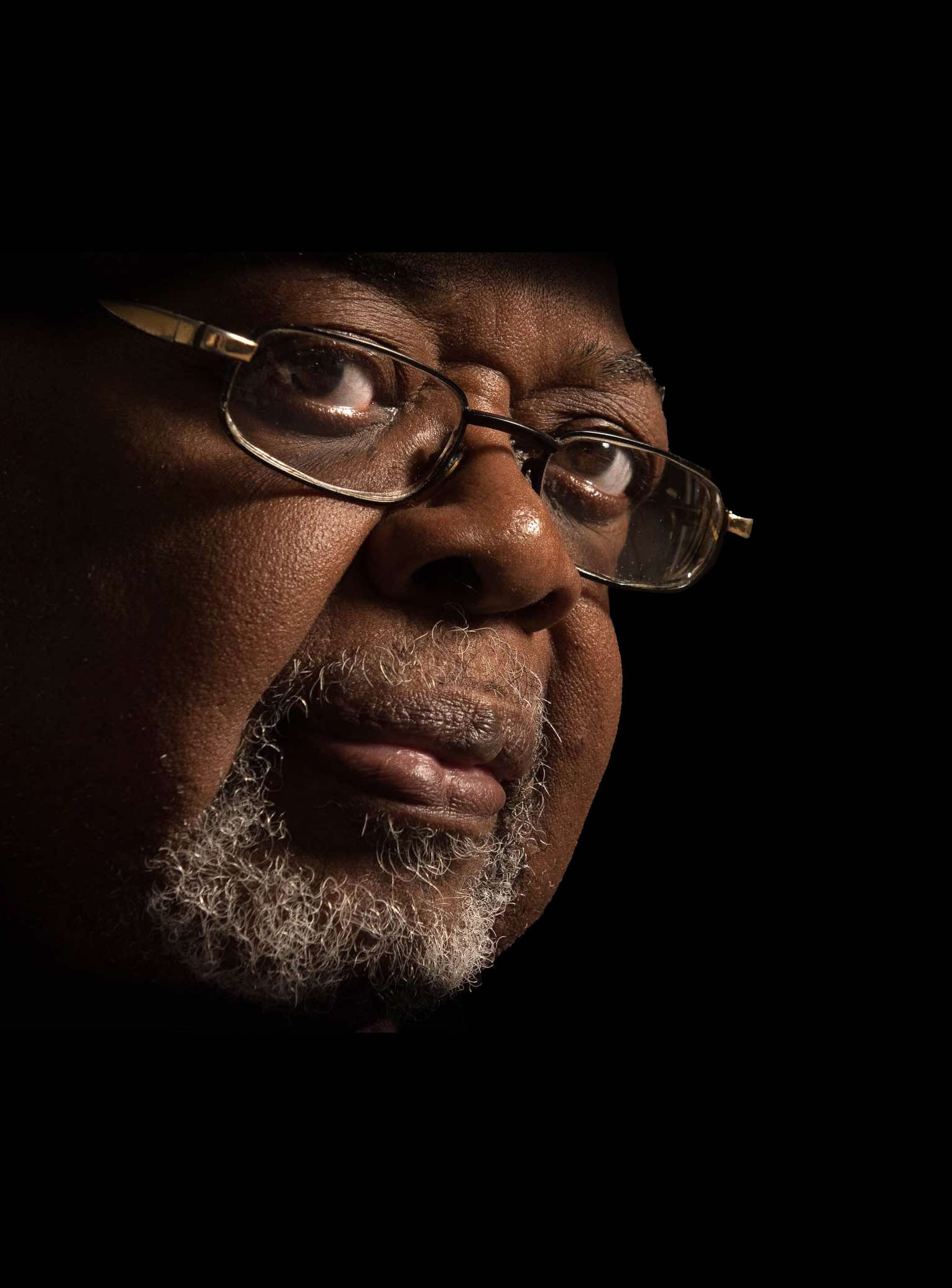
A life on the Hill
The journey of Sala Udin mirrors the experience of many African American Pittsburghers
by Steve Mellon

by Steve Mellon
Sala Udin’s life is an odyssey that winds through the city’s jazzy but poor Lower Hill and into the heat and hostility of the Jim Crow south, then back to a changed and sometimes volatile city. His story is a reflection of the hopes, dreams, fears and frustrations of an often invisible and unheard population.
Students at Pittsburgh CAPA collaborated with the Post-Gazette to illustrate scenes from Sala's life and bring their perspectives to the story.
Chapter 1
Shubuta, Mississippi
Chapter 2
Pittsburgh's Hill District
Chapter 3
Staten Island, New York
Chapter 4
Durant, Mississippi
Chapter 5
Holmes County, Mississippi
Chapter 6
Lewisburg Federal Penitentiary
Chapter 7
California-bound
Chapter 8
Pittsburgh City Council
Chapter 9
Macedonia Baptist Church, Pittsburgh
Chapter 10
Centre Avenue, Hill District
About the illustrations
Writing & Coordination
Steve Mellon
Editing
Lillian Thomas
Design & Development
Zack Tanner
Advertisement
Advertisement
Chapter 1
by Steve Mellon

Shubuta bridge (Illustration by Isaiah Baynes)
One winter night nearly a century ago, as families across the United States prepared to celebrate the birth of a savior, a young pregnant woman named Maggie Howze stood on a bridge with a rope around her neck. She pleaded with a gathered crowd that she shouldn’t be hanged. It wasn’t fair, she said. She didn’t kill anyone.
Her protest moved one man to action. He emerged from a collection of enraged white faces surrounding Maggie and struck her twice with a metal wrench. One blow knocked out several of the young woman’s teeth, the other opened a gash in her face.
Then it was time for death.
And so this Pittsburgh story begins, in a small Mississippi town called Shubuta, five days before Christmas in 1918. The world at that moment was breathing a sigh of relief. The Great War had ended. Four years of mechanized killing had come to an end, thank God. In Shubuta, however, white residents welcomed death as an honoree.
Sala Udin has never seen Shubuta or its ugly bridge, yet he thinks about the place quite often. From a book-lined basement office in his Pittsburgh home, Sala plugs into an online world of census reports, birth certificates and death records in an effort to find fragments of his family’s history. It’s a tedious process and Sala, now 73, has been at it for years. He’s convinced the Shubuta bridge, 900 miles from his home, is a part of his story, perhaps a key. Yet finding a record or document that directly links Sala’s family to the events that occurred on the bridge has proved difficult.

Shubuta bridge in 2015 (Steve Mellon/Post-Gazette)
A few years ago, Sala was in Jackson, Miss., to attend a conference and decided to drive into the eastern part of the state to find the Shubuta bridge. As he neared the town, however, the sky grew dark with clouds. Rain began to fall. Soon, the rain came down in torrents and Sala had difficulty seeing the road. He asked himself, “Why are you driving into Shubuta? You’ve not contacted anyone to let them know you’re coming. You don’t know anyone there.”
On this day, with heavy drops pounding on the steel roof of his automobile, Sala turned around and headed back to Jackson.
And so he continues his search for an understanding of the events that unfolded on a distant bridge more than nine decades ago.
Central to the story are four young African-Americans who’d been lodged in Shubuta’s jail. Two were sisters, Maggie and Alma Howze. Some accounts state Maggie’s age as 20, others 22. Alma was 16. With them were brothers Major and Andrew Clark, ages 20 and 14.
Both Howze sisters were pregnant, Alma noticeably so. She was due to give birth in a few weeks.
The Howze sisters and Clark brothers were charged with conspiring to kill a white man named E.L. Johnston. A later investigation revealed that few people believed the Howze sisters or Clark brothers had anything to do with the death of Johnston, a philandering, failed dentist who had made a number of enemies.
No matter. It was enough that the four were black and had become entangled in the reckless life of a white man. Johnston, 45, was living on his father’s Mississippi farm when he was shot while milking a cow.
Major and Andrew Clark immediately emerged as suspects. The brothers were courting the Howze sisters, and Johnston was thought to have had relationships with both Maggie and Alma.
Authorities wanted a confession from Major Clark. They got it after crushing the young man’s testicles between the metal jaws of a vise. He implicated Maggie, Alma and Andrew. Then, at around 8 p.m. on Dec. 20, a few men entered a local power station and shut off Shubuta’s electricity. Several automobiles rumbled into the suddenly dark town.
A deputy sheriff surrendered the jail to a gathering mob, and the four suspects were forced into a car and driven a short distance to the Shubuta bridge. There, white hands secured ropes around black necks.
Certainly the Howze sisters and the Clark brothers understood the hopelessness of their situation. Blacks in Mississippi feared violent retribution for all sorts of transgressions -- using the wrong door to enter a house, failing to move off a sidewalk to make way for a white person, drinking from the wrong water fountain. It was the white power structure’s method of maintaining a brutal status quo.
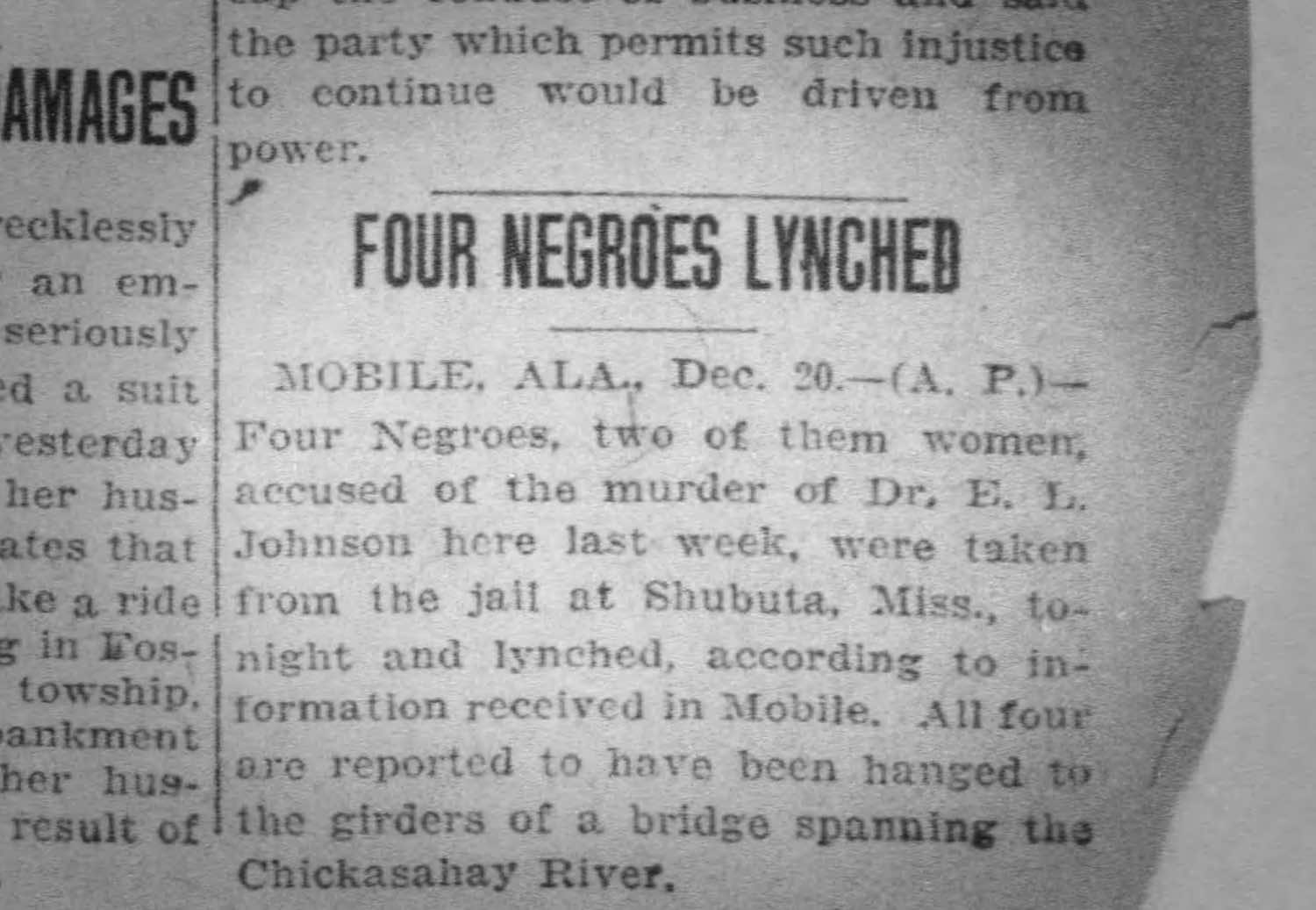
Post-Gazette article on the Shubuta lynchings.
After Maggie’s face was smashed by the wrench-swinging man, someone, or perhaps several people, tossed each victim off the bridge. Alma Howze and the Clark brothers fell several feet before their descents were violently arrested by the ropes around their necks.
Maggie, however, grabbed a bridge support as she was thrown from the span. The mob hauled her back up, then tossed her a second time. Again, she caught herself. On its third attempt, the mob succeeded. Four bodies hung lifeless from the Shubuta bridge. Two of those bodies bore developing children.
Gravediggers buried the young victims on Sunday. Rumor spread through Shubuta that workers could see movement in Alma Howze’s womb.
News of the lynchings soon reached members of a decade-old organization called the National Association for the Advancement of Colored People. One of its officers was a light-skinned black named Walter White, whose appearance allowed him to “pass” as a white man. He traveled to Shubuta to investigate, and his account of the incident was published in a 1919 report titled “Thirty Years of Lynching in the United States, 1889 to 1918.” A tattered copy of this report is held at the Carnegie Library in Oakland.
The story carries significance for Sala Udin for one reason: Sometime in the months before that night of horror on the bridge, a 9-year-old boy living somewhere in Mississippi, not far from Shubuta, climbed into an automobile with his sister and a few other relatives and began a long journey north.
Sala wonders if the boy had some connection to the sisters murdered on Shubuta’s bridge. Perhaps the boy’s parents sensed trouble and hustled him away to a place where blacks did not have to live in fear of being thrown from bridges and hanged.
That boy was William H. Howze, Sala’s father. He was heading to a place called Pittsburgh.
Continue Reading
Chapter 2
Pittsburgh's Hill District
Chapter 2
by Steve Mellon
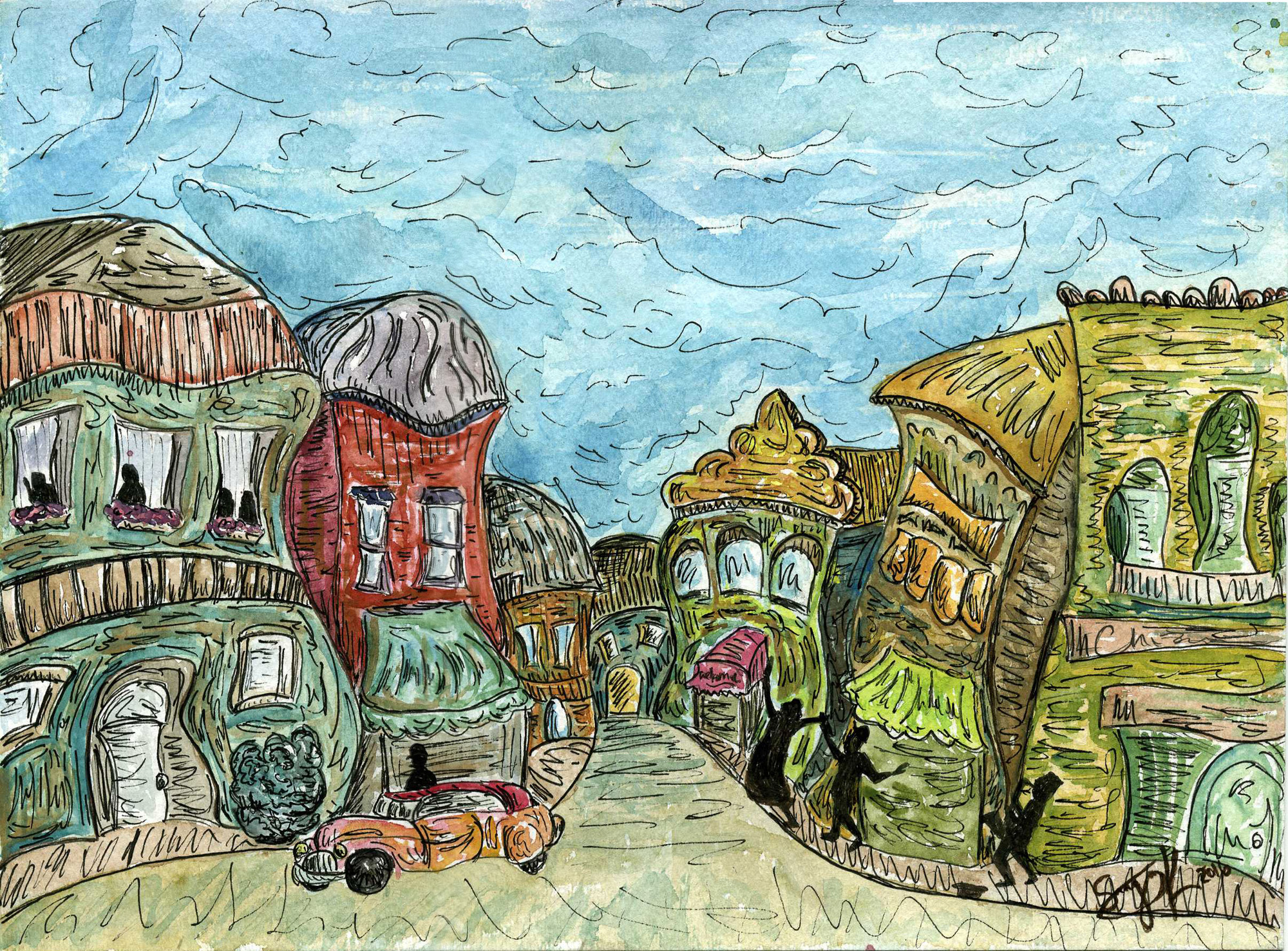
Hill District life (Illustration by Sagar Kamath)
Young William Howze entered second grade at Manchester Public School on Pittsburgh’s North Side in the fall of 1918. A school record identifies him as “William Carter” -- he’d taken the surname of his sister Della’s husband, Oscar Carter.
He lived with the Carters in an apartment in the 1200 block of Decatur Street, a cobblestone alley lined with narrow brick homes and wood-frame garages. The 1920 census lists him as “William McGruder.” McGruder was his mother’s maiden name.
Many of his neighbors were, like him, blacks who’d migrated north from Alabama, Mississippi, Virginia. They’d left places blazing with sunshine to live in a slate gray industrial city whose air was thick with tiny pieces of burnt earth belched from industrial smokestacks.
Most of the men on Decatur Street worked as laborers at mills or on railroad gangs. During Prohibition, some took up bootlegging. The street could be rough. Two blocks from William’s home, an argument over broken milk bottles in July 1922 ended in a stabbing death. Decatur had a domestic side, too. In the 1100 block, Mrs. Mamie Horn hosted the Sunshine Sewing Circle.
Sometime in the mid- to late 1920s, William met another young Southerner, Mary Ella Sutton. Mary was born in Savannah, Ga., in 1910 to a pipe-smoking carpenter and traveling Baptist preacher named Richmond Virginia Sutton and his wife, Amie, a housekeeper. Mary moved to Pittsburgh in the early 1920s to live with her sister Anna and Anna’s husband, Lemon Moses, a mechanic.
William and Mary wed in 1929. Then came children: Delores, Della, William Jr., Donald, Eunice. A dozen in total. They lost one child to tragedy -- 2-year-old Daniel was struck by a car and killed on Wylie Avenue in 1940. Another died at birth.
The seventh child was born in 1943. He was christened Samuel Howze, a name he would discard as an adult.
William and Mary moved their family into Pittsburgh’s Lower Hill, a crowded neighborhood butting against the Downtown district. The Lower Hill was lively and diverse, home to, among others, African-Americans, Italians, Jews and Syrians. Newspapers considered the neighborhood a slum and ventured there only to cover vice or to photograph children living in squalid conditions -- the Lower Hill was notorious for decrepit housing.
By the early ’50s, the Howze clan had moved to an apartment above a grocery store at the corner of Epiphany Street and Fullerton Avenue. It was a drafty place owned by a landlord slow to repair broken windows. In winter, cold overwhelmed the radiators. For warmth, the Howze children huddled together in bed.
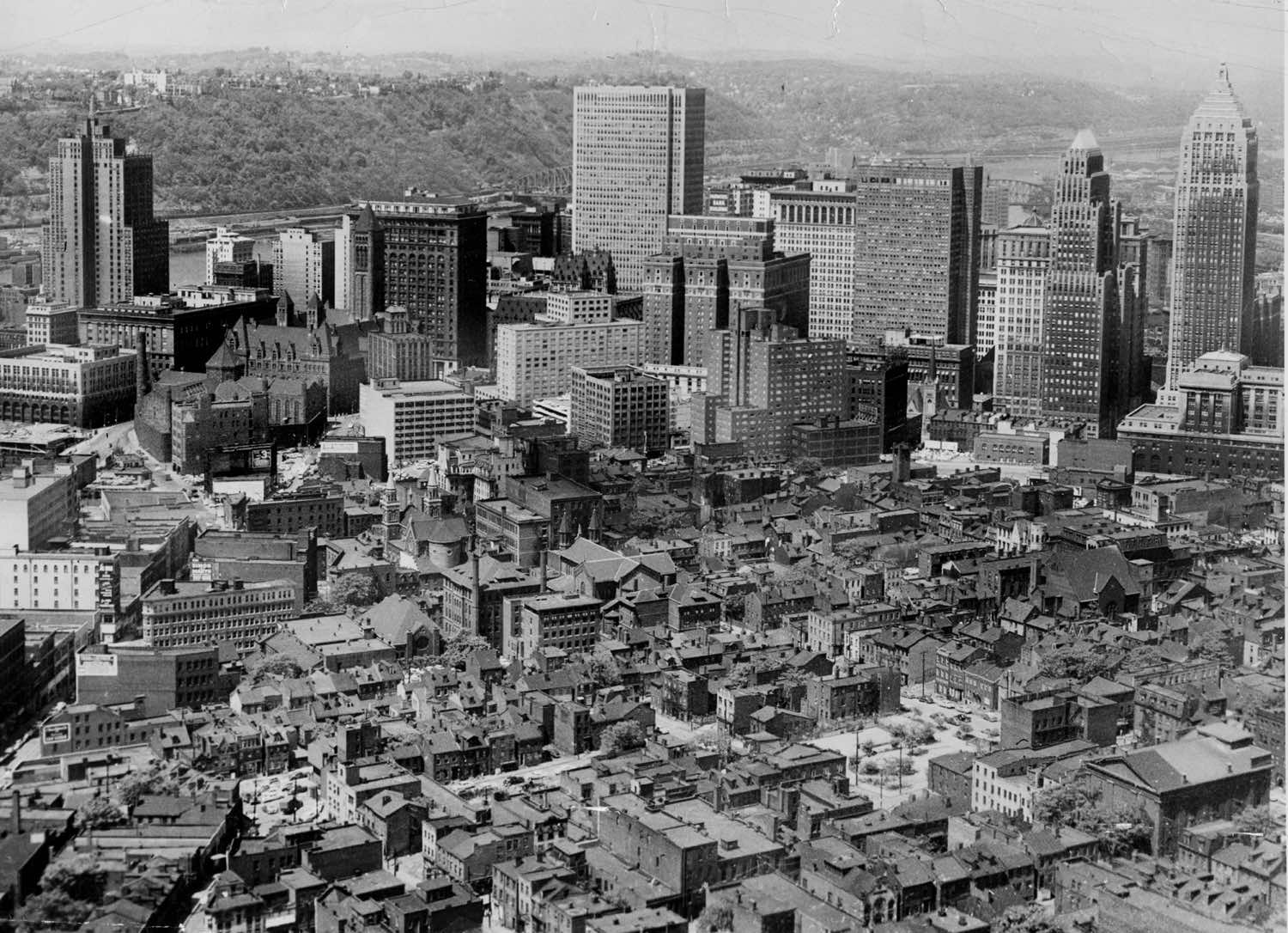
Pittsburgh’s Lower Hill District. (Post-Gazette)
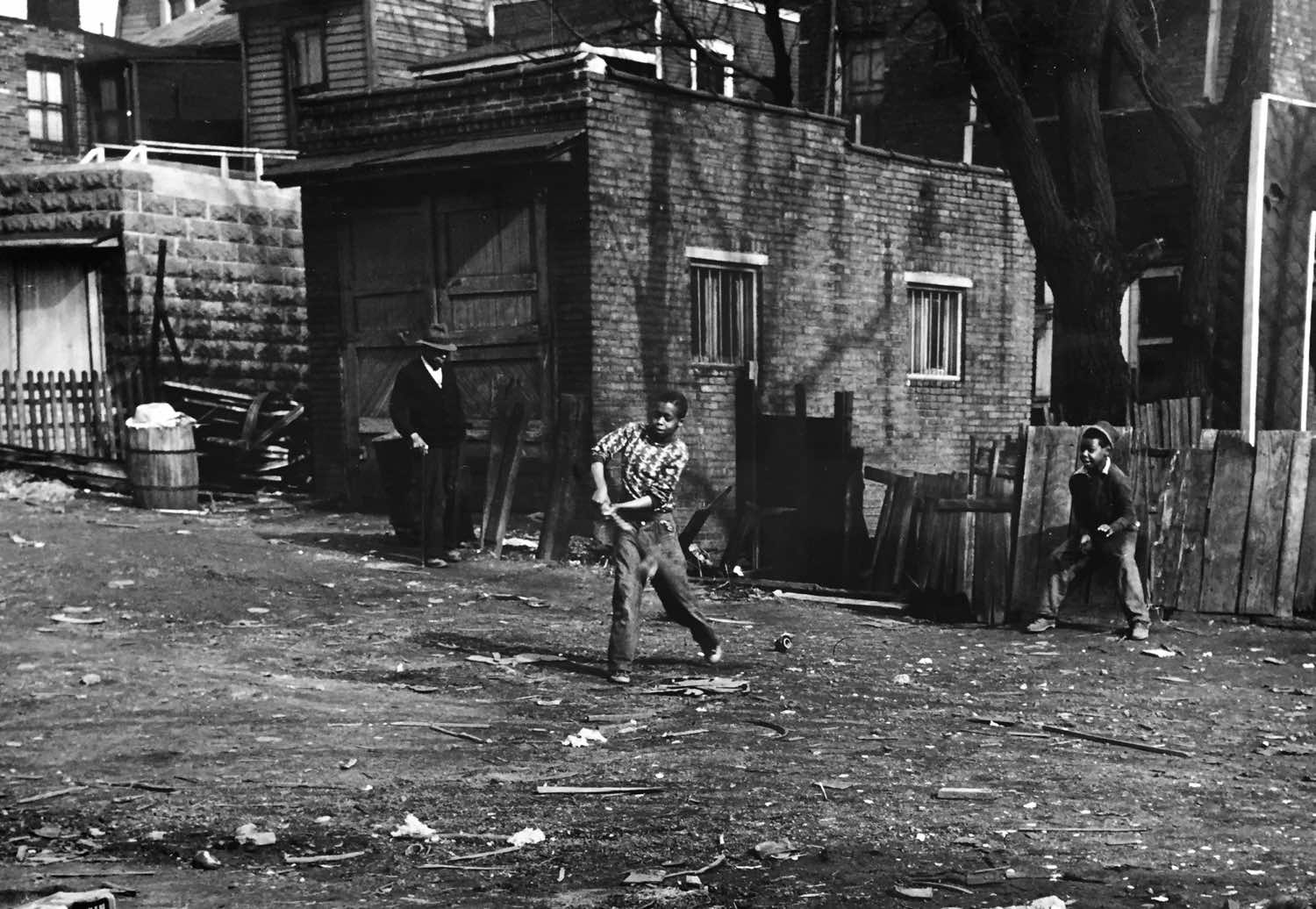
Boys playing stickball in the Hill in 1951. The game was one of Sam’s favorites.
Epiphany Street was a playground, stickball a favorite game, with a broomstick for a bat and a grits box serving as a ball. At dusk, attention turned to Fullerton, burning with light and life. Howze children leaned against pillows on windowsills in their apartment and marveled at the activity along the street below -- men in snappy suits and hats, women in beautiful dresses, folks glad-handing, talking to each other, laughing.
The Lower Hill served as a center of African-American culture, and Fullerton was its heart. Sam and his siblings watched people enter clubs like the Lowendi and Stanley’s and the Rhumba and Kelly’s, places where jazz leaked out onto the street when the doors opened, then faded as the doors closed.
William labored long hours as a presser in an industrial laundry on the North Side. Mary worked as a housekeeper for families in Squirrel Hill and at Holy Trinity, where Sam attended grade school. She also ran the Howze household, and made certain the kids were fed and got to school on time.
After dinner, William sat in a padded chair at home with his feet propped on a milk crate until he fell asleep. Mary would later wake him and send him to bed.
Fridays, though, were different. On that day, William shopped for groceries after work and, when he arrived home, pursed his lips and blew a loud, distinct whistle that served as a call for his children, whose job was to carry the groceries into the family’s kitchen.
Later that night, William would slick back his hair with tuxedo grease, put on a shirt and tie, place a hat atop his head and disappear out the front door to enjoy a night on the town. Hours later he’d return, tipsy, and call for Sam to sit on his lap. In those moments he would tell Sam that he loved him. On sober nights, there was none of that talk. Sober William was a hard man. His children were simply to follow his commandments -- do your homework, clean up your room, do your chores.
One evening in 1953, a truck arrived in front of the Howze apartment. Time to load up, William barked. Soon the truck was stuffed with the family’s belongings and rumbling up Bedford Avenue, higher in the Hill District. A left turn at Francis Street took the family into a newly built section of the public housing complex Bedford Dwellings. This was now home.
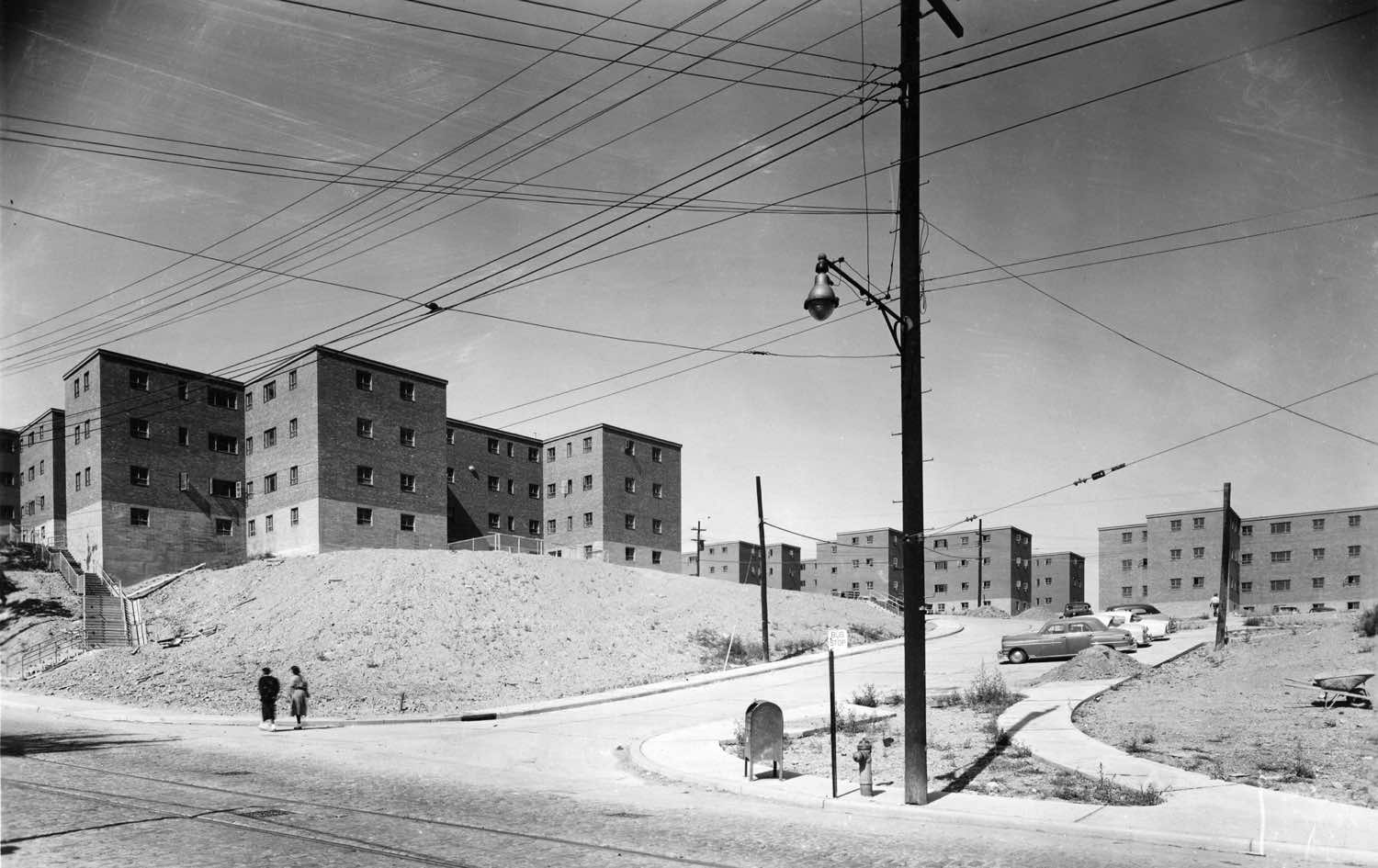
Bedford Dwellings in 1953.
It was an exciting time for 10-year-old Sam -- everything inside the apartment was new. New refrigerator, new stove, new sink, new countertops. And the place was warm. “Daddy must have hit the numbers,” Sam thought.
In truth, hundreds of families were moving out of the Lower Hill. Within a few years, the neighborhood’s rickety houses would be demolished to make way for a steel-domed structure called the Civic Arena.
The extent of the destruction became apparent to Sam a few years later, when William Howze packed his kids into the family’s Plymouth and drove them down to see the old neighborhood. Bulldozers and backhoes had completed their work. None of the Lower Hill’s landmarks remained. Gone were the clubs, the houses, the old grocery store at the corner of Fullerton and Epiphany, the streets where Sam and his friends had played stickball. Everything had been flattened. Sam was bewildered. All traces of a vital, vibrant neighborhood were obliterated. It was as if it had never existed.
At Holy Trinity, nuns would sometimes rub Sam’s head for luck and call him “Little Black Sambo.” But he was just a child and gave little thought to the color of his skin, especially in the racially diverse Lower Hill.
That changed in 1955, when Sam was attending St. Richard school on Bedford Avenue. In the school’s playground Sam noticed some of his friends huddled in a circle. He figured they were ogling a girlie magazine. He was curious, so he rushed over to take a look.
The kids, he saw, were studying a graphic, disturbing image published in Jet magazine. It showed a dead boy -- was it a boy? It was so hard to tell, with the skin and flesh on the face distorted into a grotesque mask. An accompanying story described the brutal murder of Emmett Till, 14, beaten and shot in the head by white men who accused Till of flirting with a white woman in Money, Miss. Till’s corpse was dumped in the Tallahatchie River.
Till’s mother insisted on an open-casket funeral. Sam wondered, “Why did she allow her son to be photographed that way? Was she trying to tell us something?”
Sam’s education continued at Central Catholic High School. At lunch, Sam and a few other black students sat together at a table surrounded by a sea of white kids.
One day, Sam and his friends set their books on a table, then got in line to get food. When they returned to their seats, they found a note. “This is black history month,” it read. “Invite a nigger to dinner tonight.”

Sam Howze at Central Catholic. (1959 Central Catholic High School yearbook, Detre Library & Archives, Heinz History Center)
Sam and his friends glared at a table of white kids nearby. The troublemakers. “This is it,” Sam said. “We ain’t taking no more.” Punches flew, trays and food fell to the floor.
Sam transferred to Schenley High School. There, color wasn’t an issue -- the school had a large black enrollment. But a strange thing happened. Boys who accepted and knew him on the basketball court in school suddenly forgot his name and ignored him during the most important social event of the day -- an after-school gathering on Centre Avenue. There, he was invisible. Girls wanted nothing to do with him.
The problem, Sam figured, was his background. He was a poor kid from the projects. Other Schenley students lived in the middle-class neighborhood of Schenley Heights. They wore button-down shirts, new shoes and jackets. Schenley was divided not by color, but by the amount of money your parents earned and where you lived.
Sam grew to despise school.

Students gather on Centre Avenue after classes at Schenley. (1960 Schenley High School yearbook, Detre Library & Archives, Heinz History Center)
Home life on Francis Street was no better. Sam was an obstinate, rebellious teenager, constantly pushing against William’s rules and wishes. The results were predictable.
At the breakfast table on a warm Saturday morning, William gave Sam $5 and told him to go to a nearby store to buy bread. On the way, Sam ran into his pal Boogie, who challenged him to a game of one-on-one basketball. Let’s bet, Boogie said. Dollar a game.
Easy money, Sam thought.
Hours later, Sam returned home empty-handed. He told his father he’d lost the money and had spent the entire afternoon looking for it. William wasn’t buying the story. He exploded, “Go to your room and don’t come out until it’s time to go to school on Monday.”
William was in the kitchen, pulling back the lever on an ice tray. He continued screaming, “You’re good for nothin’, you’ll never amount to nothin’.”
As Sam turned and walked to his bedroom, he heard his mother plead, “No, Bill, don’t, you’re going to kill him!”
Sam glanced back. The ice tray whizzed past his head. He ducked into his bedroom and remained there until Monday morning.
Everything spiraled down for Sam. His grades plummeted. A counselor pulled him aside.
“Some people are good with their brains; other people are good with their hands,” the counselor said. “It’s obvious to us that you’re probably good with your hands. So we’re going to suggest you transfer to Conley and learn a trade because the likelihood is you’re not going to college.”
That was enough for Sam. He dropped out of school. Why not? He was 16. School was doing him no good.
Sam heard that his friends Melvin, Red and Boogie were moving to New York. Red had a car. Sam was invited. Pittsburgh offered nothing but problems. New York looked like a good option. When Pittsburghers moved to New York, they returned with wads of money, new cars. The decision was easy.
Sam informed his older sister Beverly, who cried, but kept the news to herself. William Howze, especially, would go ballistic if he knew of his son’s intentions. Sam had to plan his exit carefully. It would be at night. He’d need Beverly’s help.
From his bedroom, Sam could glimpse down a hallway and past the kitchen, but couldn’t quite see his father sitting in his living room chair. Beverly was his lookout. She would signal her brother as soon as William nodded off to sleep.
So Sam waited. Finally, Beverly gave the sign. Sam picked up his basketball and the rest of his belongings, stashed in a brown paper bag, and slipped quietly past his snoring father and out the front door. Soon, he was in Red’s car, motoring away from Pittsburgh and toward an uncertain future.
Previous Chapter
Chapter 1
SHUBUTA, MISSISSIPPI
Continue Reading
Chapter 3
STATEN ISLAND, NEW YORK
Chapter 3
by Steve Mellon
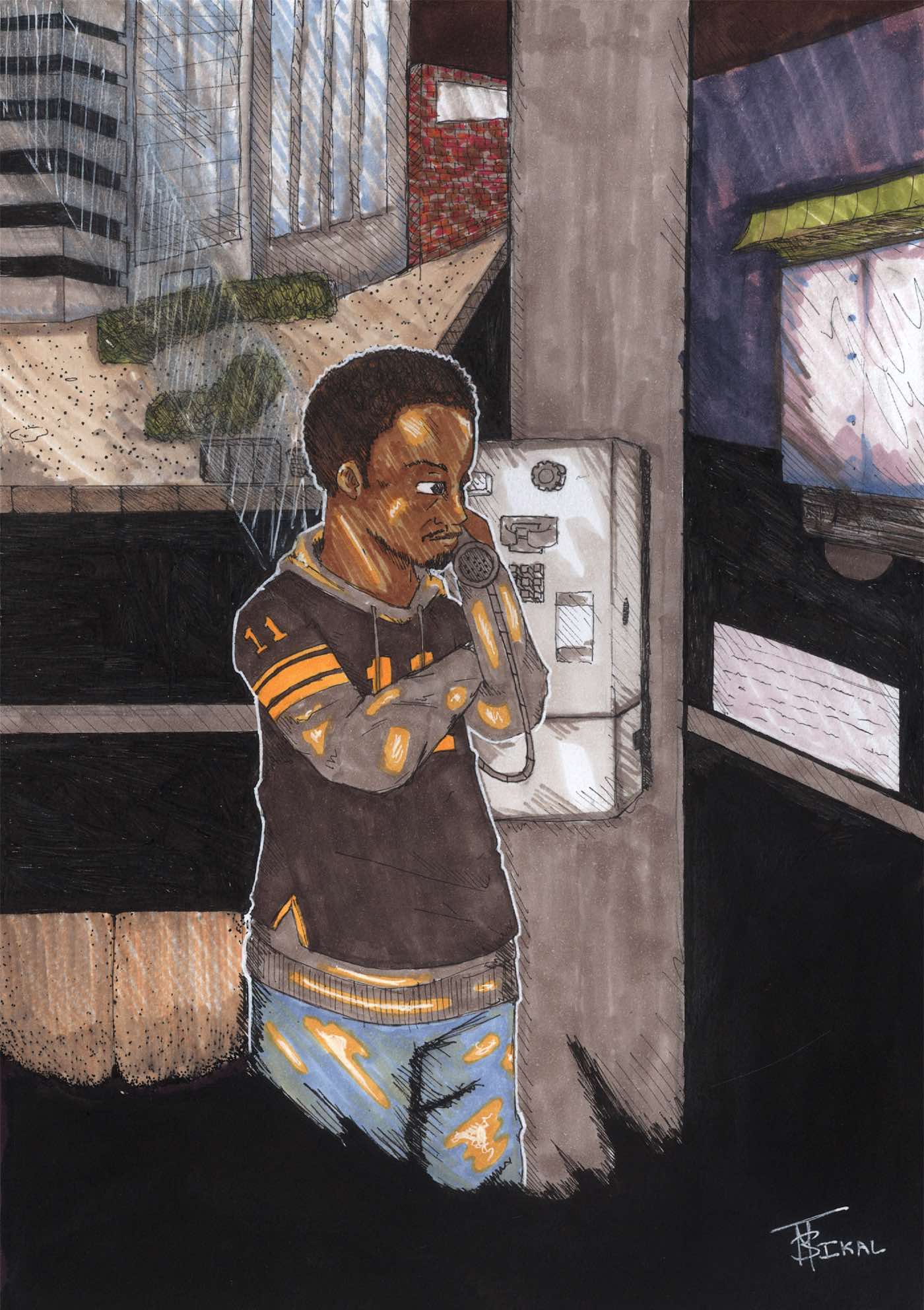
Seeking a lifeline (Illustration by Mikal Burns-Terney)
Hurtling eastward in a massive old Buick, Sam Howze and his three friends could look out the window at the unfamiliar countryside rushing past and revel in the excitement of the moment. For Sam, especially, the adventure seemed sweet. Finally, he was free. Free of his father’s rules, free of his shrinking box of a hometown, free of the idiots who called him “nigger,” free of the well-dressed snobs who ignored him.

Finding a new identity in Staten Island (Illustration by Mikal Burns-Terney)

Changed by Dr. King’s message (Illustration by Mikal Burns-Terney)
The young men rolled into Brooklyn, parked near Red’s father’s place and stretched their road weary and stiff frames as they climbed out of the car. Red’s father took one look at the ragged Pittsburgh crew and said to his son, “You’re blood, you can stay. But I don’t know these kids, they’re not staying at my house.”
So the four drove to Harlem. Red, sticking with his friends, knew people there. Maybe they would offer the Pittsburgh guys a place to flop. Maybe not. Driving through the jammed canyon streets of Manhattan, Sam’s excitement faded. He was a hungry and broke 16-year-old kid, a high school dropout in a strange city where his first experience was yet another rejection. He needed a lifeline.
He had one option. Two of his mother’s sisters lived in the New York City borough of Staten Island. Sam found a phone booth and gave them a call.
Within moments, he was talking with his aunt Edna Ballard.
“How you doing?” she said.
“I’m fine.”
“Boy, your mother’s worried sick about you,” said Aunt Edna. “You’ve been gone two days and she has no idea where you are.”
“Oh, I’m OK.”
“Alright. Well, you get on over here now and see your auntie.”
So Sam left Melvin, Red and Boogie and headed to Staten Island.
There, he entered yet another unfamiliar world. His aunts both worked as nurses and lived together in a middle class neighborhood. Cupboards were filled with food. Clothes lined the closet of Aunt Edna’s son Forest, who was the same age as Sam.
Aunt Edna appraised her nephew. “Look son,” she said. “You don’t have to pretend with me. Why don’t you stay here? You can move into Forest's room.”
Only for a few days, Sam said. But his aunts quickly made arrangements. They bought Sam some clothes, shoes, new underwear, sweaters and sent him with Forest to Port Richmond High School on the island’s North Shore.
There, all of Sam’s unwanted identities fell away. He was no longer a poor kid from the projects. He was a cousin of Forest, a handsome and popular product of a middle class home. This made a world of difference. Students liked and accepted Sam, teachers encouraged him. Sam’s grades improved dramatically.
Port Richmond’s student body was mostly white. Sam had attended a white school before, with disastrous results. This time was different. His skin color made little difference at Port Richmond. He was invited to dances and parties. Classmates loved the way he talked -- they kidded him about his Pittsburgh accent, the way he said “warshed” and used words like cupboard and gumband.
He got involved in fraternities and clubs. Sam discovered he had what adults called the “gift of gab.” When he talked, people listened. Sam learned to step out, to be in front. He was becoming a leader.
On March 15, 1961, Sam received bad news from Pittsburgh. His father had been admitted to West Penn Hospital to undergo kidney surgery. While on an operating table, William Howze suffered cardiac arrest. A coroner ruled his death an accident. He was 51.
Sam left his classes at Port Richmond, boarded a train and endured a cold, miserable trip to his hometown. He had always viewed his father as a difficult old man, constantly angry, filling the house with his thunder and his rules, convinced his defiant son was destined to be a bum. Now, “daddy” was gone. It happened so fast, so unexpectedly. Sam had matured in New York. He had learned to appreciate the lessons his old man had taught him. Yet Sam never admitted this to his father. Sam never told him, “I’ve turned out OK.”
As the train rattled westward, hope for reconciliation withered in the chilly March air.
Sam graduated from high school in 1962 and immediately embarked on a career path he’d picked on a whim years earlier.
He had chosen a profession at age 7 or 8 to answer a question grown-ups were always asking: “What do you want to be when you grow up?” Sam sized up the adults in his neighborhood, looked for someone he could emulate. One man stood out. His name was Mr. Charles, and he always wore a three-piece suit, a crisp white shirt and a tie. His shoes always were shined and he drove a black Cadillac.
What did Mr. Charles do? Sam asked.
Why, Mr. Charles is an undertaker.
Sam had his answer, and it came with a bonus -- it got him attention and chuckles.
Years passed. Sam never bothered to change his story about wanting to become a mortician. And so after graduation from Port Richmond, his Aunt Edna surprised him with news that she had agreed to pay for his first semester at a mortuary school in Manhattan.
Sam found himself in a Manhattan morgue, learning to embalm the dead. He also learned the basics of the funeral business -- contract law, accounting, business management principles. Dealing with lifeless bodies didn’t bother Sam, and he did well in his classes, even secured an internship in a funeral home in Harlem. But the most important lesson he learned was this: He didn’t want to spend the rest of his life working at a funeral home.
But what did he want to do?
While Sam pondered his future in the summer of 1963, organizers finalized plans for an event called the March on Washington for Jobs and Freedom. Sam had by now been elected leader of the youth council of the Staten Island chapter of the National Association of Colored People. The chapter had chartered a bus and set aside 10 seats for the youth council. Sam was asked, Can you find 10 kids who want to go?
He recruited enough young people to require a second bus.
So on Aug. 28, Sam joined an estimated 250,000 marchers gathered on the National Mall to hear speeches and performances by, among others, Roy Wilkins, John Lewis, Josephine Baker and Bob Dylan.
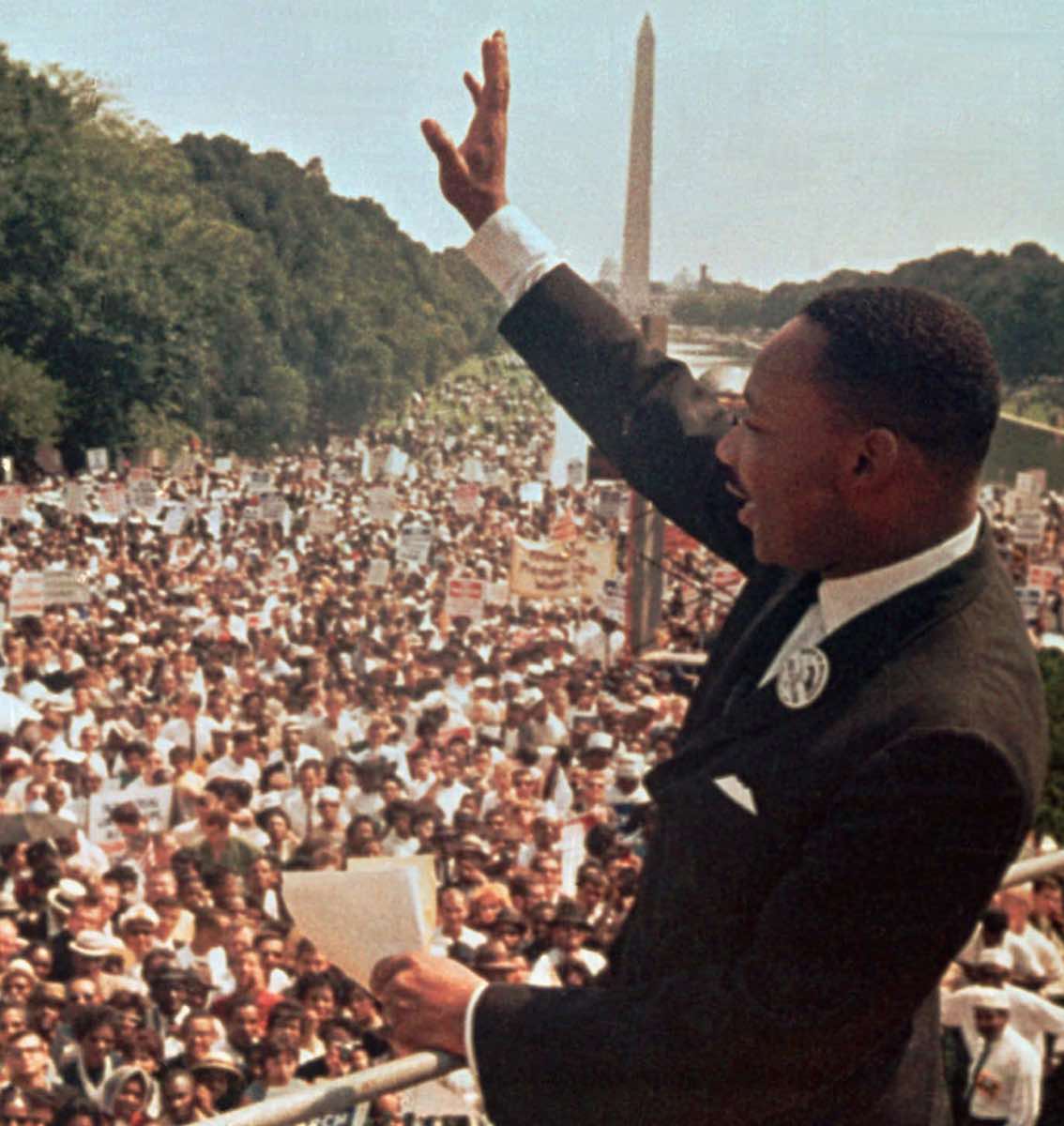
Dr. Martin Luther King Jr. at the Lincoln Memorial during the March on Washington, D.C., Aug. 28, 1963. (AP)
The day’s final speaker was Dr. Martin Luther King Jr. Standing on the mall, Sam watched King approach the podium on the steps of the Lincoln Memorial and was struck by the civil rights leader’s size. Sam had envisioned King as larger than life -- but the man Sam saw from a distance stood 5-feet-7.
“I am happy to join with you today in what will go down in history as the greatest demonstration for freedom in the history of our nation,” King began.
For the next 16 minutes, King’s words echoed over the mall. Those words would inspire millions and change the course of Sam’s life.
“I have a dream that one day even the state of Mississippi, a state sweltering with the heat of injustice, sweltering with the heat of oppression, will be transformed into an oasis of freedom and justice,” King said. “I have a dream that little children will one day live in a nation where they will not be judged by the color of their skin but by the content of their character ….”
As King’s speech ended, Sam made up his mind: “I want to be a part of his army. I want to be a part of what he just talked about. Sign me up.”
Previous Chapter
Chapter 2
PITTSBURGH'S HILL DISTRICT
Continue Reading
Chapter 4
DURANT, MISSISSIPPI
Chapter 4
by Steve Mellon
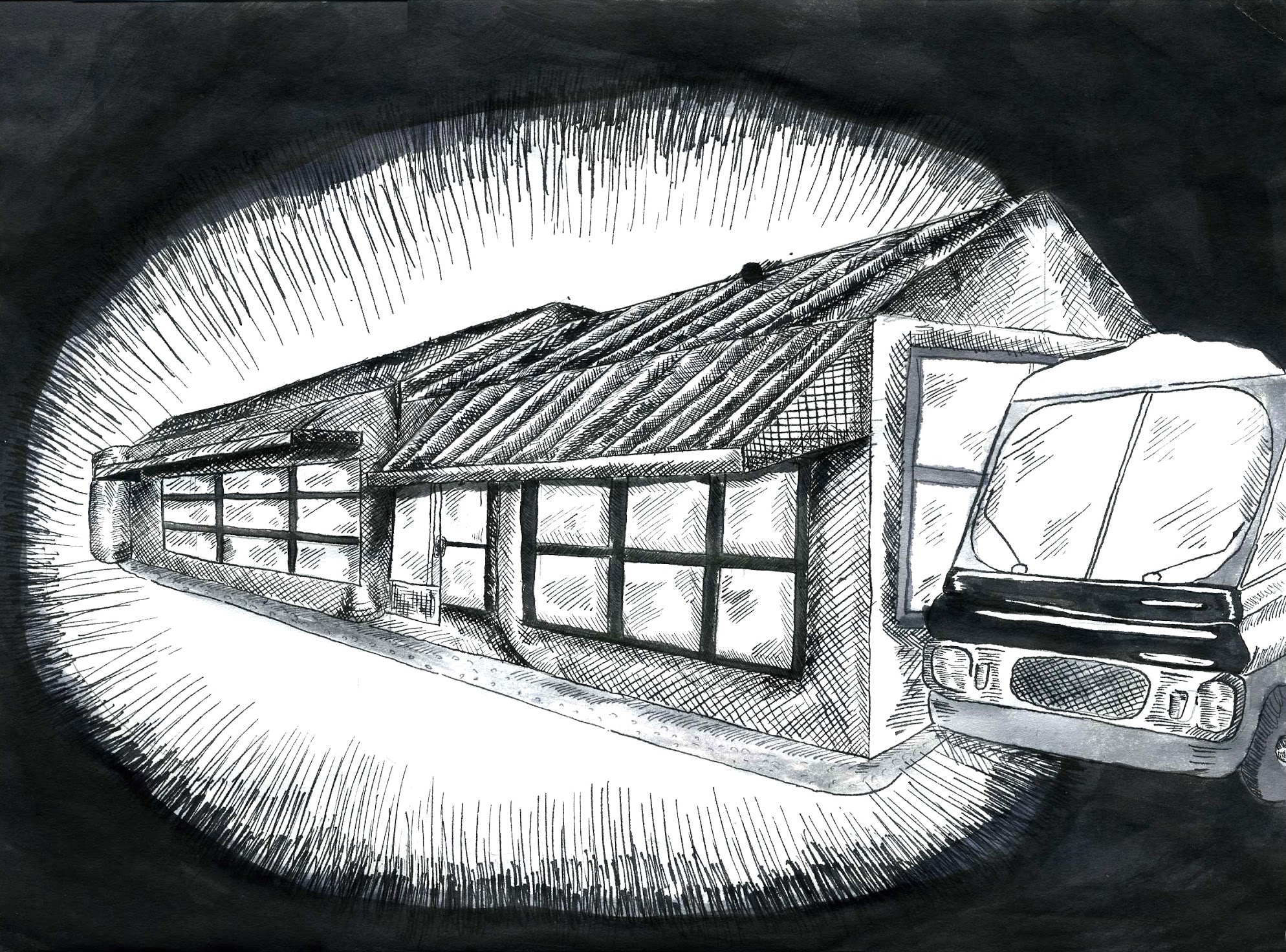
Bus arrives at the Durant Cafe (Illustration by Nell Hendricks)
The Greyhound bus rumbled into one southern town after another, hissing to a halt at diners and cafes that doubled as bus stops. At each town Sam Howze stepped off the bus, dropped a coin in a phone booth and made the call.
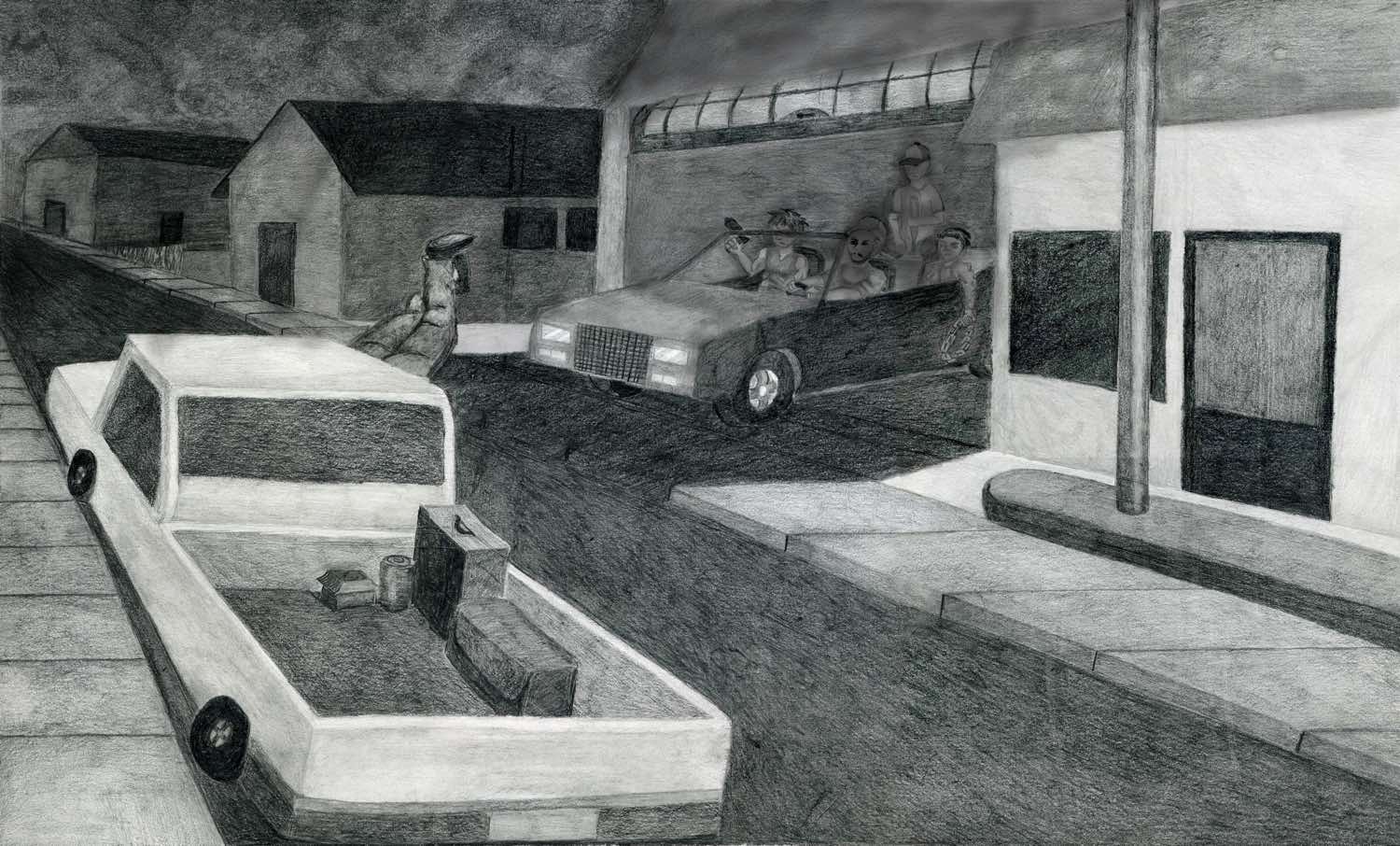
Escape from the Durant Cafe (Illustration by Deaven Spuriel)
And each time the same operator answered and gave Sam the same bad news: No one’s picking up at the Freedom Office in Lexington, Miss.
The sun dropped low. Sam looked out the window at the darkening landscape. He was getting worried. This was his first trip into the South -- a place his parents had warned him about. And the man who was supposed to meet him, the man who had recruited Sam as a civil rights worker, was unreachable. Sam wondered, “Where is Don Hamer?”
The bus ventured deeper and deeper into Mississippi. A decade earlier, Emmett Till had come this way and within a few weeks his battered and mutilated body was packed in a casket and sent back home to Chicago. And just 12 months ago, authorities had dug the remains of three murdered civil rights workers from an earthen dam near a Mississippi town named Philadelphia.
Sam remembered the words his mother spoke: “Son, your dad and I are from the South, we know what the South is like, your mouth is much too big to go to Mississippi. You're going to get in trouble.”
“But ma,” Sam had replied. “I’ve got to go.”
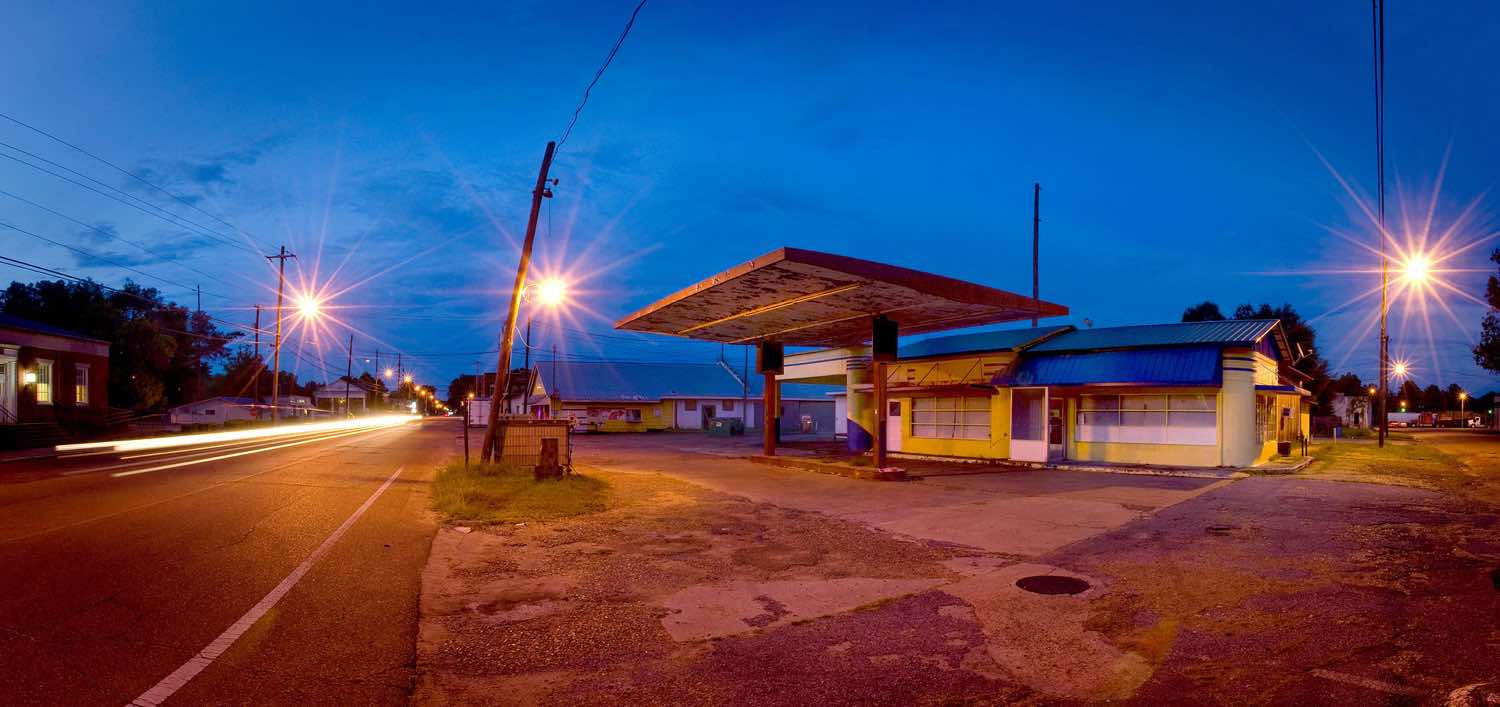
Cafe in Durant, Miss., as it looks today. (Steve Mellon/Post-Gazette)
Sometime after 2 a.m., the bus entered the town of Durant. At this hour, it was a place of desolate sidewalks and squat brick buildings. The driver pulled into a gas station with an attached diner. This was Sam’s stop, the Durant Cafe. He exited the bus with his bags, looked around. No Don Hamer. So he reached into his pocket for a dime to make a phone call. Lights illuminated the diner. Sam saw people inside. He walked in through the front door.
The place was small. A few men sat at a food counter. Behind the counter stood a woman. No one paid Sam any attention. After a few moments, he set down his bags and asked, “Can I get a cup of coffee, please? And where’s your pay phone?”
From behind the counter came the woman’s swift, brutal reply.
“Nigger, if you want a cup of coffee, you better carry your black ass around to the nigger window and you’ll get a cup of coffee there. How dare you walk in the front door?”
Sam looked at the men sitting at the counter. One wore a police uniform. He stared at Sam, put a hand on his gun.
The 1965 trip to Mississippi started with a girl.
Sam had asked a young woman in Pittsburgh for a date, she had said yes. But first she wanted to hear a civil rights speaker at a church on Centre Avenue. That was OK with Sam. He really liked this girl. They agreed to meet at the church.
Sam arrived early. People drifted in. Where was his date? She hadn’t yet arrived. Sam yearned to smoke a cigarette but wondered if he’d be allowed to light up in the church building. He approached a young, slender white guy standing at the church door. “Can we smoke in here?” Sam asked.
“I was wondering the same thing,” the young man replied. “Maybe we better go outside.”
So the two walked out of the building, shared a light.
“What brought you here?” the man asked Sam.
“I want to date this chick,” Sam replied, “and she made me attend this event. So I gotta listen to some knucklehead speak before we can go out.”
“I know how that is,” the man replied.

Sam’s trip to Mississippi began at a Centre Avenue church. (Illustration by Victoria Kipiller)
After a few moments, the two went back inside. The evening’s program was about to start. Finally, Sam’s date arrived.
The master of ceremonies discussed the civil rights work taking place in the South, the bravery of volunteers confronting Klan violence, the efforts to register voters and chip away at segregation.
“Ladies and gentlemen,” he said, “we’re honored to have as our speaker this evening Mr. Don Hamer from Lexington, Mississippi.”
And the guy Sam had just spoken with rose from his seat, glanced over at Sam and smiled. Sam wanted to crawl under the pew.
Hamer described the work taking place in the Mississippi Delta. Sam was spellbound. He had wanted to be part of Dr. King’s effort. This guy Don Hamer had the key.
The next day Don and Sam met for coffee and talked in more detail. I’m in, Sam decided. I’m going to the Mississippi Delta.
Now, in Durant, Sam stood alone in an openly hostile place, facing an armed man. He picked up his bags and walked out of the Durant Cafe. Where in the hell is Don? Sam looked out at the street. There, on the corner, was a phone booth. There is a God, Sam thought. Once again he tried calling the Freedom Office. This time, there was an answer -- finally, it was Don Hamer.
“Man, this is Sam, I'm in town, I’ve been calling you for two days.”
“I’m so sorry,” Don said. “We went to Jackson for a demonstration, and I got arrested. I made bail and just now got back home. I’ll come and pick you up. Where are you?””
“The Durant Cafe.”
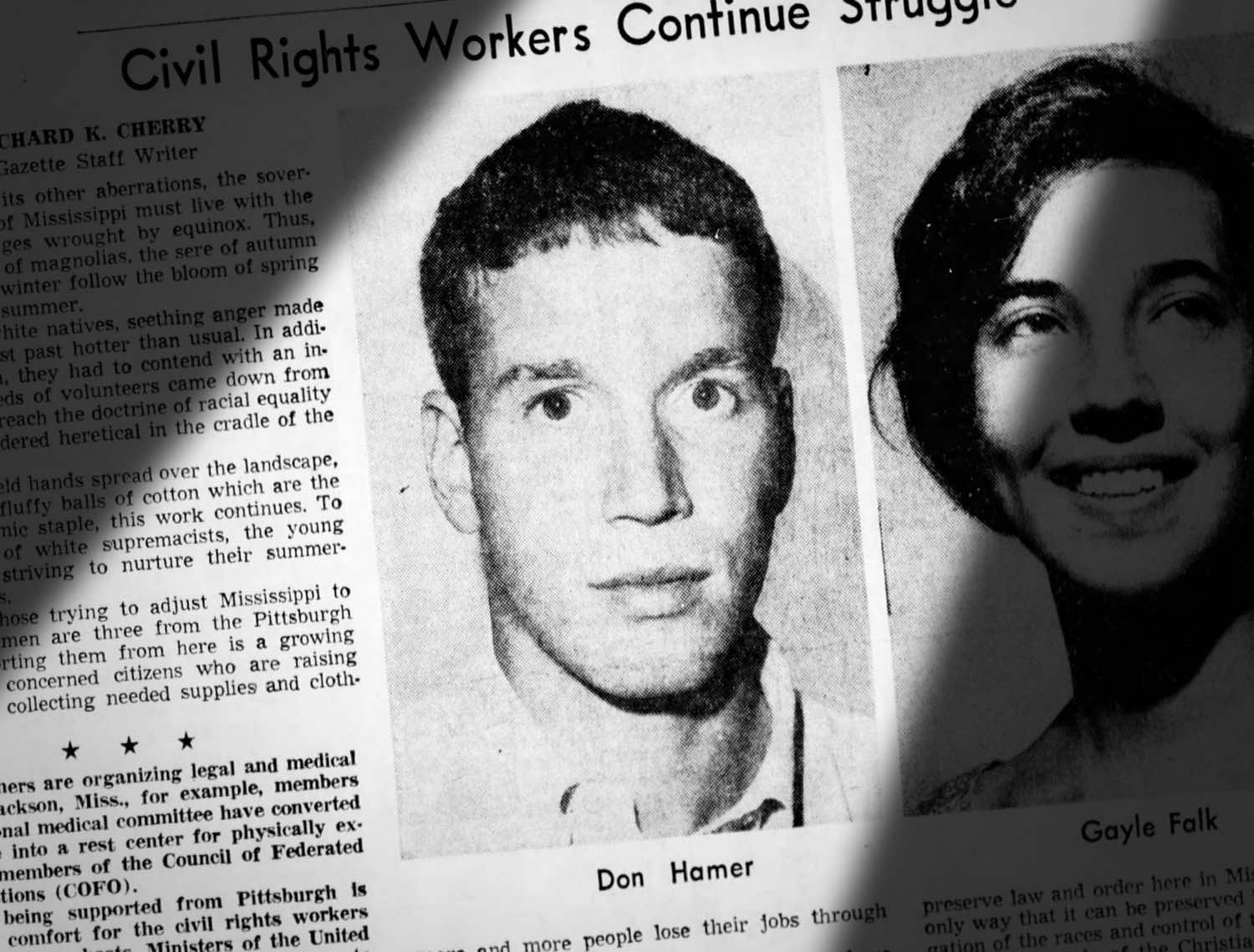
Don Hamer, in a Post-Gazette article about his Mississippi work in 1964. The article stated he was from Wilkinsburg. (Post-Gazette)
“What? The Durante Cafe?” Don was alarmed. “Get out of there right now, get your stuff, go across the highway and wait for me there.”
Sam hung up the phone and walked back to the cafe entrance to get his bags. As he approached the door, the uniformed officer came out, glanced at Sam’s bags and said, “This your stuff, boy?”
“That’s mine.”
“Get it away from the front of this door.”
Sam looked at his bags. Looked at the door. The bags were not a hindrance. The officer once again put his hand on his gun. Sam got the message. He lifted his bags and carried them to the other side of the highway, where he sat down on one of his suitcases and waited.
Sam watched as the officer got into his police car and drove with lights out to the back of the cafe. A few moments later, the door to the attached service station rumbled opened and out raced a convertible carrying five white men. One was swinging a chain, another fired a gun into the air. The vehicle swerved across the highway and ground to a halt beside Sam.
“You one of them goddamn civil rights workers aren’t you?” one of the men asked.
“We been waiting on you.”
“What?” Sam replied. “I ain’t no civil rights worker. I’m down here visiting my uncle.”
“Who’s your uncle?”
Sam remembered a name Don Hamer had mentioned: Luke Simms.
“Luke Simms my uncle.”
“I know Luke Simms,” said the white man. “He’s a good ole boy, he better be your uncle.”
The convertible screeched back over to the garage, and the men waited there to see if Luke Sims would come to pick up this new visitor.
Sam tried to be calm. He sat with his chin in his hand, as was his habit, but he was shaking so much his chin slipped out.
Don Hamer, driving a white pickup truck, understood the situation as soon as he neared the cafe. He cruised past Sam, then whipped the vehicle around and came flying back, stopping beside Sam. “Throw your stuff in the back and jump in,” he hollered.
Soon, Sam and Don were roaring east down two-lane State Road 12. The convertible flew out of the cafe parking lot in pursuit. The chase was on.
“If we get to Gene's house we’ll be OK,” Don hollered. Sam wasn’t sure what he meant.
Don headed to the Holmes County seat of Lexington, 10 miles away, but police there were waiting -- they’d apparently been notified by authorities in Durant. When the white pickup approached the Lexington town square, Don turned north and sped along State Road 17 with more vehicles giving chase. After seven miles, Don slowed and turned onto a narrow dirt road. The truck kicked up a cloud of dust. Vehicles in pursuit backed off.
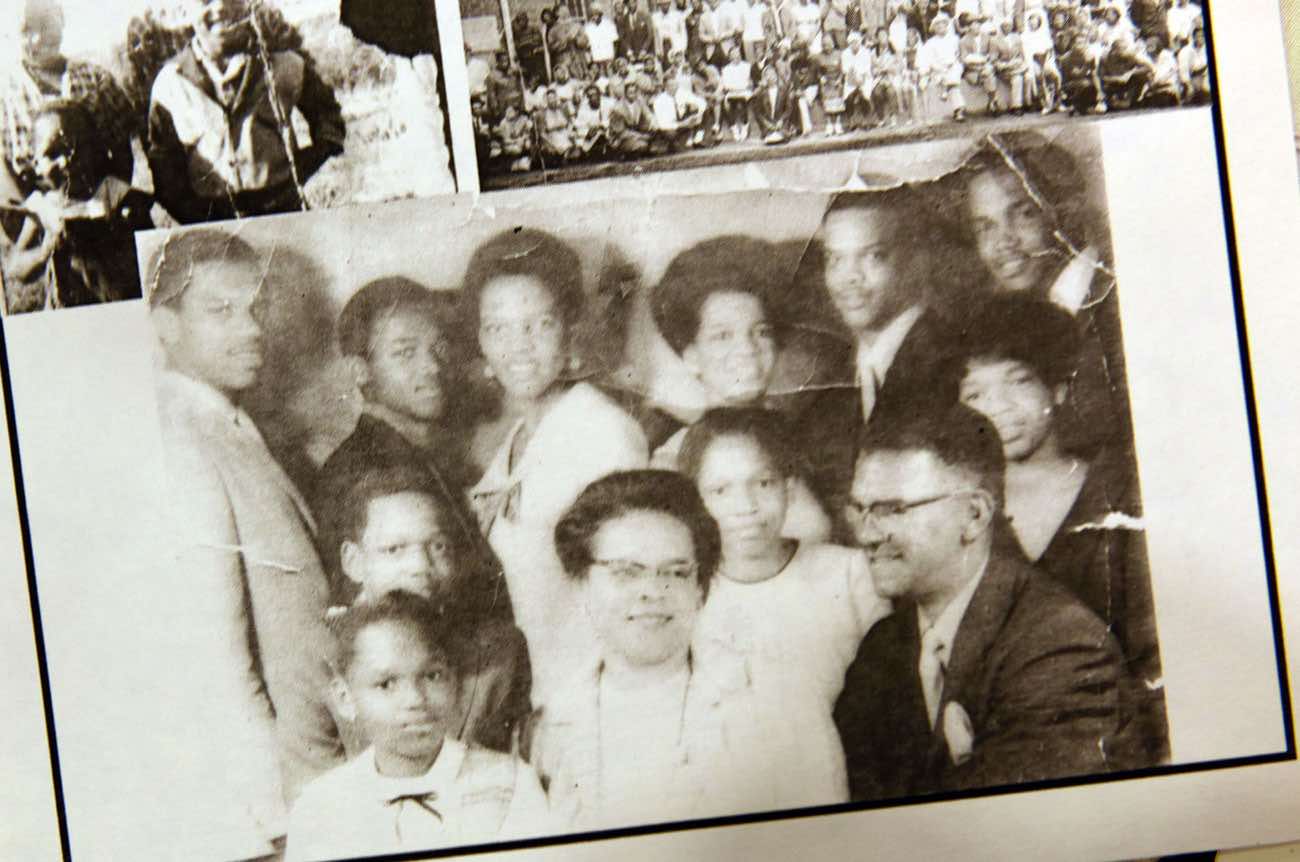
Gene Montgomery and his family in the 1960s. (Courtesy of the Montgomery family)
Moments later, Don pulled up to a wood-frame house and killed the motor. They had arrived at the home of Gene Montgomery, a fiercely independent black farmer who often housed newly arrived civil rights workers. Whites didn’t mess with Gene. Gene was crazy. Even his kids said so.
“Howdy, boy,” Gene barked at Sam. “Come in and sit down.” Then the tall, wiry farmer called to his kids, “Somebody give him something to drink.”
Daughter Zelpha Montgomery peered into the room. She and her siblings had never seen anything like this before. Oh, the family had provided temporary housing for other civil rights volunteers in the past -- in fact, two were staying in the house when Don and Sam arrived. Those workers were always white. Sam Howze was black -- the first Northern black volunteer they’d ever met.
And he was rattled. His experience at the cafe and the mad dash to the Montgomery house had unnerved him. Zelpha fully expected the skinny young man from Pittsburgh to hop on a bus the next morning and head back north.
But when the sun rose, Sam’s bags remained unpacked. This time, he would not run away.
Previous Chapter
Chapter 3
STATEN ISLAND, NEW YORK
Continue Reading
Chapter 5
HOLMES COUNTY, MISSISSIPPI
Chapter 5
by Steve Mellon

Breaking a rule in Mississippi (Illustration by Ada Griffin)
Early one morning, Gene Montgomery woke his 15-year-old son Byron and announced the two of them were going to town.
So father and son drove along dirt lanes and then paved roads in Holmes County, Miss. They passed farms similar to their own 200-acre spread and, after several miles, entered the Lexington town square. Gene pulled into a parking space not far from the town’s red brick courthouse.
Hot, sticky air had already settled over the small town of about 2,500. Folks get thirsty on a day like this. Gene led Byron on a search for a public water fountain. They found one labeled “Whites Only.” Gene bent over and took a drink. Then he told his son to do the same.
They went to another water fountain, also labeled “Whites Only,” and again both took a drink. This continued throughout the town — Gene leading his son from one segregated water fountain to another, both father and son taking a sip.
Finally, Gene and his son marched into the mayor’s office.
“If you white folks want to drink out of these public water fountains again,” Gene announced, “You’re going to drink after a black man, because me and my son just drank out of every one.”
The mayor promptly called the town’s police chief, who lodged Gene and Byron in a jail cell. After a few minutes, Sam Howze arrived to bail them out.
Byron was startled: How did Sam get to town so quickly?
Ah, he thought, Sam was prepared. He must have helped plan this protest. Years later, the thought of Gene and Sam conspiring in such a clever and subversive act would make Byron chuckle.
Sam Howze and Gene Montgomery came from strikingly different backgrounds — one was a middle-aged Southern farmer, the other a young activist from a Northern city. But both were willing to take risks when challenging Holmes County’s segregated, racist culture. Their actions seemed fearless. It’s no wonder Sam’s stay at the Montgomery house, intended to be temporary, stretched into months and then years, and that Sam came to be considered a member of the large Montgomery family.
Sam’s work with Gene and other residents in Holmes County would have lasting effects. Years after the Saturday morning water fountain protest, Byron recalled the result: Town leaders turned off all of Lexington’s water fountains. And they remained forever dry.
Holmes County’s population in the 1960s was 70 percent black. Like Gene, many of the county’s African-American residents were independent farmers. Some had begun to push back against the violence and intimidation designed to keep them “in place.”
Gene always carried a pistol and propped a shotgun by the front door of his house. If you shot at Gene, he’d return the favor. This earned him a measure of respect — or at least fear — from hostile whites.
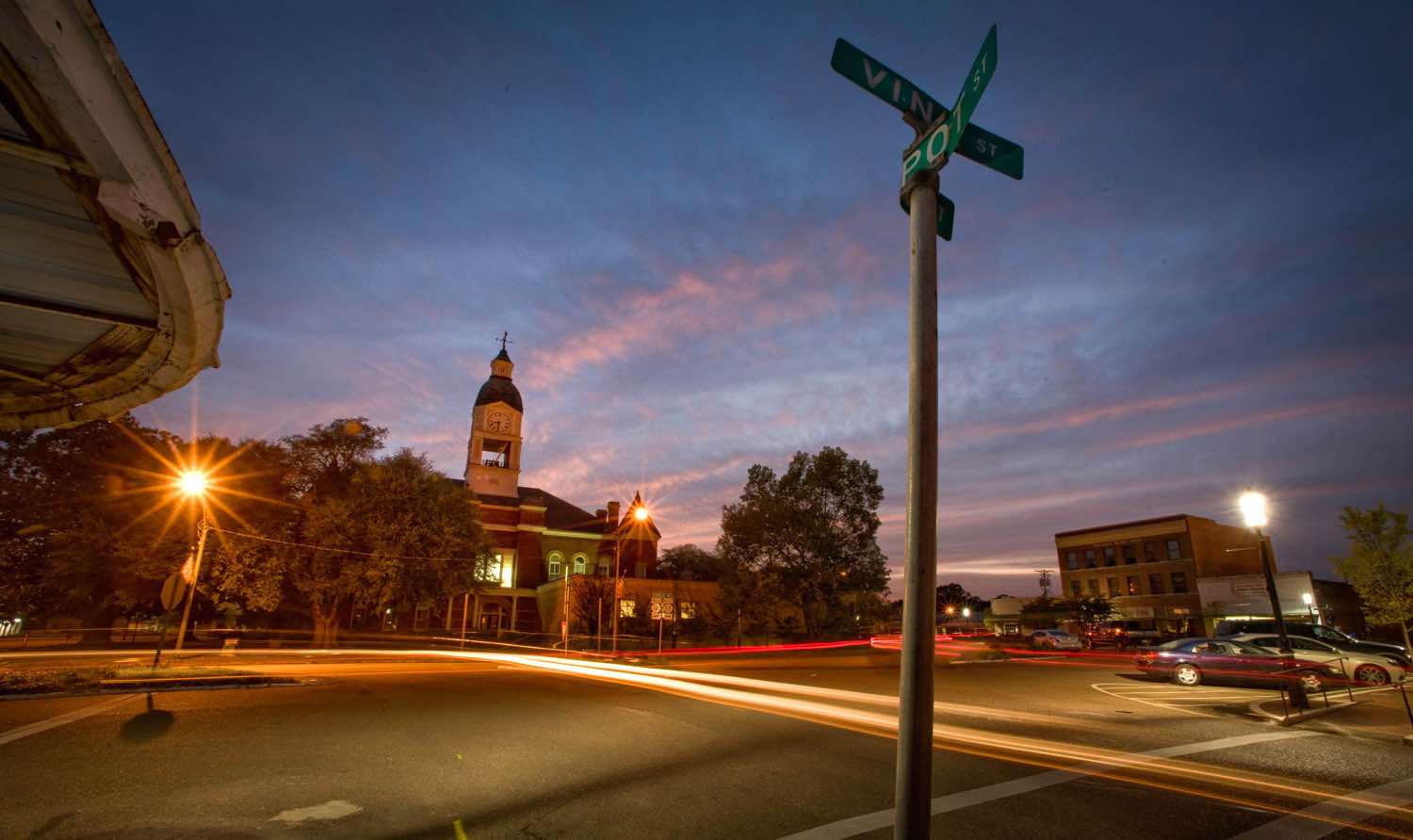
Holmes County Courthouse in Lexington, Miss. (Steve Mellon/Post-Gazette)
Sometimes Gene and his wife Bernice hosted weekend get-togethers for those in the movement. These gatherings of idealistic young people hanging out and swimming in a nearby pond were tempting targets for the Ku Klux Klan, and Gene knew it. On a few occasions, he armed Byron and Sam and stationed them across the street from the farm.
Clearly, Sam had found a place in a community determined to stand up for itself and break age-old customs.
One warm night in 1965, officials in Holmes County conducted a meeting to explain a new federal Head Start program. Since Head Start aided children regardless of race, both black and white parents trudged up the courthouse steps and entered a large second-story meeting room.
Soon the room was filled with farmers fresh from their fields, mechanics who had come straight from garages, store clerks, teachers and a number of other workers. These people were united in that they were all relatively poor.
Following tradition, whites sat in chairs on the right side of the room, blacks on the left. Sam took notice. He’d been in town just a few weeks and already he seethed with anger and resentment at the way black people in Holmes County were forced to stoop and bow and say “Yassir” and get off the sidewalk when a white person approached. Every day revealed multiple insults. It was a way of life.
So Sam decided to make a change. He walked across the room and sat on the white side.
White people gave him hateful stares. Blacks whispered: He’s going to get himself killed. Sam was joined by only one other black person — Gene Montgomery, of course. Everyone else gave the two a wide berth. Chairs for at least a few rows behind them remained empty.
The move was largely symbolic. Sam survived the night unscathed, and the courthouse meeting room remained segregated. But at least on this occasion, the status quo was challenged.
Mostly, though, Sam’s work in Holmes County involved organization and education and did not involve such direct confrontation. For example, he took a leading role in organizing blacks to become members the county allotment board and thus make certain black farmers received a fair allocation of acreage to plant cotton. Traditionally, blacks were given fewer acres than whites, a practice that sometimes forced black farms into bankruptcy. He helped folks with paperwork, and assisted with voter registration efforts that would soon lead to the election of several African-Americans to local and state offices.
People in Holmes County remember Sam as a tall and skinny young man with a large Afro atop his head. His hair greatly annoyed one Lexington law enforcement officer, a heavyset African-American everyone called “Fat.”
Fat called Sam names like “nappy head” and threatened to toss him in jail where, the officer said, he’d get a pair of shears and cut the Afro down to size. Sam wasn’t afraid to prod authority. He stopped combing his hair, which became a riot of kinks. Of course, this further annoyed Fat.
But there was a limit. On a Friday evening in the summer of 1966, Sam learned very quickly that some rules in the American South were simply too dangerous to ignore.
Sam was alone in the small one-room Freedom Office in Lexington. The day had been a long one, and Sam was wrapping up his work. He was anxious to join his colleagues who had already departed for a weekend retreat at Mount Beulah, a former college near Jackson where several civil rights organizations held meetings and training sessions.
Sam learned very quickly that some rules in the American South were simply too dangerous to ignore.
Suddenly, another civil rights worker appeared at the office door. It was Roberta, a white woman in her late 30s or early 40s.
“Oh, I’m so glad I caught you before you left,” she said
“What is it, Roberta?” Sam asked.
“You’re the last ride out of here to Mount Beulah.”
“And?”
“I need a ride.”
Oh, God, Sam thought. This was trouble.
Civil rights workers in Holmes County often had to cover a lot of territory, and driving put those workers in a vulnerable position — they could be stopped by police for any number of infractions, jailed and harassed. So the workers followed certain rules for automobile travel: Always make certain the gas tank is full and the tires are sound; avoid driving at night; avoid integrated travel. If blacks and whites must travel together, males should travel with other males. Never should a white woman travel with a black man.
Sam explained to Roberta that he couldn’t give her a ride. You know the rules, he told her. But she pressed her case and insisted on sitting in the front seat, rather than in the back.
As they pulled out of Lexington, Sam prayed they would get to Mount Beulah without incident.
They traveled south on Route 51 at dusk. Traffic was heavy. Then Sam noticed brake lights ahead. Uh-oh, he thought. An accident. That meant police.
As the vehicle edged farther along the road, Sam’s fears increased. The delay wasn’t caused by an accident but by a roadblock — frequent occurrences on Mississippi highways.
By then he was in a line of traffic. A U-turn was impossible. Traffic narrowed to a single lane. Ahead he saw police officers waving vehicles along. Sam prayed he and Roberta would make it through unnoticed.
They didn’t. At the head of the roadblock, an officer yelled at Sam, “Pull over!”
Sam complied. “Get out of the car,” the officer commanded. Sam did so and tried to hand over his driver’s license. The officer knocked it from his hand and onto the ground.
“What are you doing with a white woman in the front seat?” he asked Sam. “You’re one of them goddamn civil rights workers, aren’t you?”
Before he could explain, Sam was struck by a blow to the face. Roberta screamed.
Sam found himself in the center of a circle of police officers. One would punch him, and then push him into another officer in the circle, then that officer would punch him and push him into another.
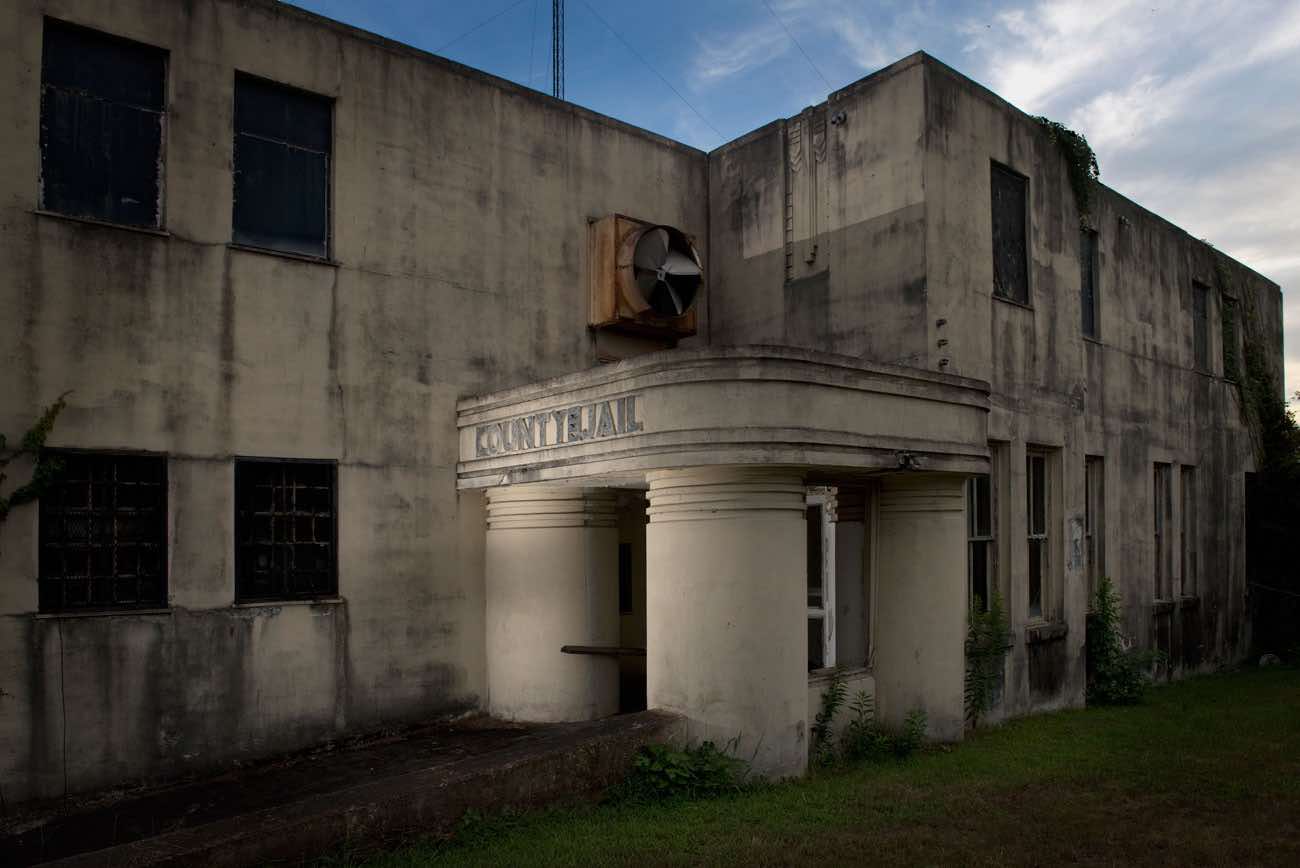
Holmes County Jail, now closed, in Lexington, Miss. (Steve Mellon/Post-Gazette)
After several moments, an officer put Sam into a police car and headed to the local jail. Officers in the vehicle questioned Sam; he answered with “yes” and “no” instead of “yassir” and “nossir,” which seemed to infuriate the lawmen.
The vehicle stopped. Sam was ordered out of the car and an officer guided him toward a jailhouse. As they approached, Sam turned and began walking toward a series of steps leading to the jail entrance. “Where you going?,” the officer barked. “Nobody told you to go up those steps. Keep walking.“
The officer kept a pistol trained on Sam. Soon, the two approached the edge of a wooded area. Sam slowed down, only to be told to keep walking.
“I’m going to be shot,” Sam thought.
The two walked several feet into the woods and then entered a clearing. Sam felt the gun pressed against the back of his head. A voice said, “You just ain’t going to say yassir, are you?”
Sam didn’t reply. A moment passed. Suddenly he felt a heavy thud against his head. A loud BANG exploded in his ears. Sam slumped to the ground.
“Am I shot, am I dead?” he wondered.
A few seconds later, a voice commanded him, “Get up, nigger. I didn’t shoot you. If you don’t get your ass up, I will shoot you.”
Sam staggered to his feet. The officer hustled him to jail and lodged him in a cell. Sam figured the officer had hit him on the head with the butt of the gun, causing the firearm to discharge.
Bleeding and sore, Sam sat on the cold cell floor. “Why are you here?” he asked himself. “Mother told you, please don’t go. But you had to go anyway.”
Eventually, he pulled himself to his feet and gazed into a piece of metal screwed into the wall — the cell mirror. He could see his dim reflection. He was a mess. At that moment, all Sam could feel was anger.
“You sons of bitches,” he thought. “You should have killed me, because I will never ever stop fighting your asses, I will never stop.”
Previous Chapter
Chapter 4
DURANT, MISSISSIPPI
Continue Reading
Chapter 6
LEWISBURG FEDERAL PENITENTIARY
Chapter 6
by Steve Mellon
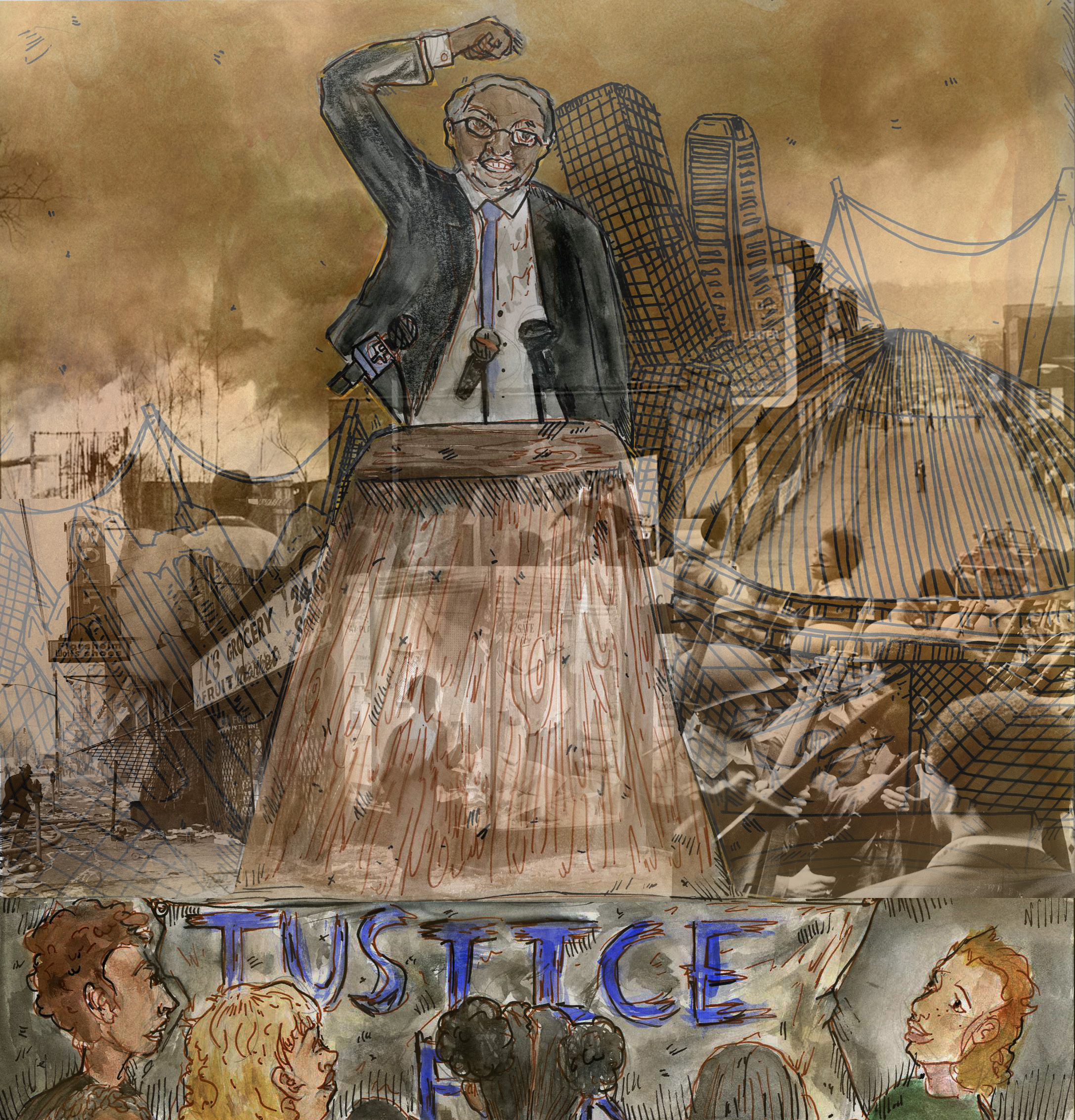
Returning to the Hill (Illustration by Olivia Grubbs)
In the spring of 1968, two men drove past Pittsburgh’s Golden Triangle, crossed the Fort Pitt Bridge and entered the dimly lit, mile-long tunnel at the bridge’s southern end.
The evening was young, the mood in the car upbeat. Sam Howze and his pal Alvin Poussaint laughed and reminisced about their experiences as civil rights workers in Mississippi. Radio music floated low and in the background. Otis Redding’s melancholy “Sittin’ On the Dock of the Bay” topped the charts. Aretha sang “Chain of Fools.”
Sam was no longer the naive kid stepping off a bus in a small Mississippi town. He’d become militant, leaned toward his African roots, wore dashikis instead of farmer’s overalls, rejected Christianity and studied Islam, questioned integration and backed Black Power. In fact, he was no longer Sam. He’d become Sala. Sala Udin.
As Sala and Alvin barreled along the parkway, a radio announcer came on, speaking in an urgent tone. “What was that about Dr. King?” they wondered, suddenly concerned.
Turn it up, turn it up.
Sala was 25 and following the shifting front lines of the civil rights movement as it moved north and into urban communities shackled to poverty, denied jobs and decent housing. Detroit, Newark, Minneapolis, Milwaukee — they’d all exploded in the summer of ’67. So far, Pittsburgh had remained relatively calm, but it was a big city with big problems. The place needed experienced organizers.
So Sala became a man of two worlds, still working in Mississippi but frequently making the daylong drive to the city of his birth.
Alvin, a doctor who was well-known for providing medical care to civil rights workers in Mississippi and helping to integrate Southern health care facilities, had come to Pittsburgh on April 4 to talk to Pitt students and organizers.
As Alvin wrapped up his talk and said his goodbyes, Sala prepared to drive him to the airport.
Around that time, 800 miles distant, a loud and explosive report echoed through a motel courtyard in Memphis, Tenn. It was not, as some people thought at the time, the backfiring of an automobile.
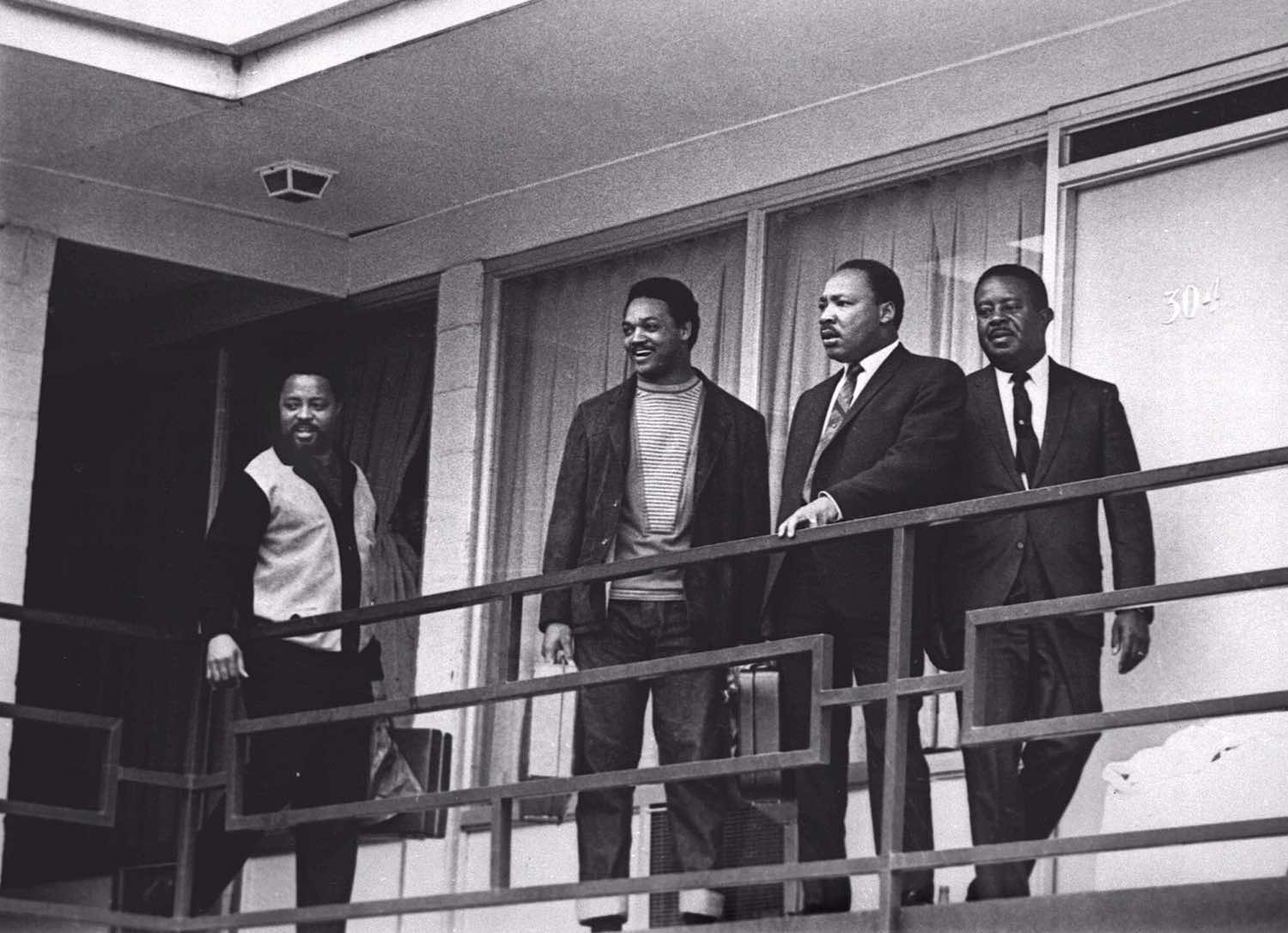
Martin Luther King Jr. (second from right) on the balcony of the Lorraine Motel in Memphis, Tenn., on April 3, 1968, the day before he was assassinated. (AP)
A man standing on the motel’s second-story balcony fell backward, his face torn by a soft-point, metal-jacketed bullet traveling at high velocity. The bullet entered near the man’s chin, passed through his neck, ripped arteries, fractured his spine.
Friends rushed to the man, his blood now pooling on the concrete. Someone called an ambulance. Police arrived within seconds.
News of the shooting traveled quickly, bulletins racing across wires, announcers breaking into scheduled programming, making special announcements.
“Dr. Martin Luther King Jr. has been shot and wounded,” one radio voice said, “possibly critically wounded, in Memphis, Tennessee, this evening.”
News of King’s shooting stunned Sala and Alvin, now nearing Pittsburgh’s airport. Five years earlier, King had stepped up to a microphone on the Washington Mall and delivered a speech that changed the direction of Sala’s life. King remained a central part of the larger civil rights struggle and Sala admired him greatly.
Sala pulled to the side of the road. There, he and his friend wept.
They were back on the road within moments. Alvin wanted to return to his family as quickly as possible.
At the airport, Sala heard whispers — “Did you hear what happened?” An African-American janitor leaned against his broom, tears streaming down his face.
Sala was anxious to return to the Hill District, already roiling with the same frustration and anger that had expressed itself so violently in other cities. Was Pittsburgh next?
In the hours after King’s death, it seemed not. Sala returned to a relatively calm city. A few crowds gathered on street corners, but no problems emerged.
The next day, tension grew thick inside city schools. Still, the afternoon brought no violence — in fact, Perry High students conducted a prayer meeting in the school’s auditorium.
Then came nightfall and the sound of shattering glass on Centre Avenue. A crowd near the Zone 2 police station began moving along the Hill’s commercial district, breaking storefront windows, looting. Police played cat-and-mouse with rioters throughout the night.
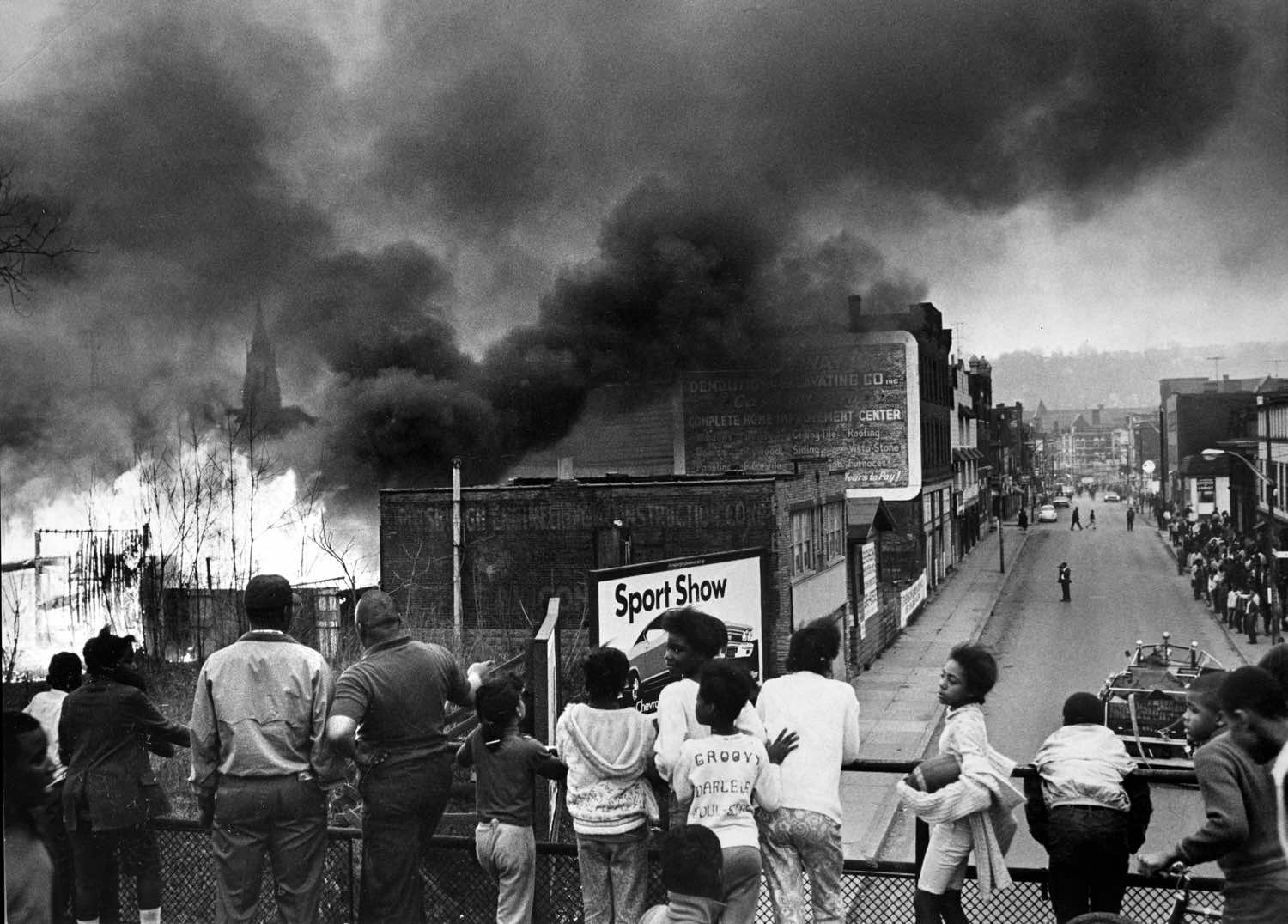
Pittsburgh erupts in April 1968. (Harry Coughanour/Post-Gazette)
Trouble continued the following day. Flames roared through a North Side pharmacy and a Centre Avenue supermarket. Firefighters dodged rocks hurled by bystanders. At a Manchester Giant Eagle, several youths rushed in, tossed flaming Molotov cocktails, then fled. A store manager urged his customers not to panic while stock boys extinguished small fires.
On-air DJs at WAMO pleaded with youths, “Be cool … Don’t let yourself get caught up in a trick bag … Don’t get swept up in a crowd.”
At one point, vandals attacked a building at the intersection of Centre and Kirkpatrick Street, where state Rep. Leroy Irvis maintained his office. Everyone in the Hill knew the lawmaker, a district representative for more than a decade. Now the Hill was burning, lawlessness reigned. The representative approached Sala, one of the city’s young militant leaders, and demanded that he stop the rioting. “I’m trying, Mr. Irvis,” Sala replied. “I’m trying.”
On this day, even the voice of a respected veteran of civil rights battles in the South carried no weight. By the time King was laid to rest in Atlanta on April 9, Pittsburgh police had arrested more than 1,200 people. Arson fires had scorched more than 475 homes and businesses.
Sala continued to shuttle between Mississippi and Pittsburgh until one day in late September 1970, when Sala and a few friends loaded themselves into a car in Jackson, Miss., and headed north. In the trunk were clothes, a rifle, a gallon of Mississippi moonshine. In Mississippi, Sala always drove with a rifle in the trunk. And the moonshine? Well, Sala would admit even years later, folks in Mississippi made some very fine moonshine.
After several hours, the vehicle approached Louisville. Sala was driving. He checked the mirror regularly. Something had been bugging him. Cars would appear behind him, then pull off. Was he being followed? Maybe I’m being paranoid, he thought.
The Mason Dixon line was just across the Ohio River. Sala always felt safer in northern states. Perhaps that is why his foot pressed harder against the gas pedal — he was simply in a hurry to put the South behind him. Near Louisville and traveling faster than the law allowed, Sala saw flashing lights in the rearview mirror.
The state police trooper asked Sala for papers, Sala opened the glove box. There, among the papers, rested a pistol.
Out of the car, ordered the trooper. Open the trunk.
“We’re done,” Sala thought.
Sala was charged with transporting firearms and untaxed distilled spirits -- federal violations -- and eventually convicted. His sentence: five years in a federal penitentiary.
This wasn’t Sala’s first run-in with the law. There were, of course, arrests and jail stints in Mississippi. And there were problems in Pittsburgh, too. In 1968, police arrested Sala as he was leaving a meeting of United Black Power in the Hill District. He had no license, and when police searched his car they found a loaded Luger in a leather holster — a gift, Sala said. A friend had earlier cleaned it for him, and Sala didn’t know the weapon was loaded. He received three months’ probation.
And in January 1969, police approached Sala and three others who were sitting in a parked car near Fifth Avenue and Craig Street in Oakland. Police asked Sala for his license. He didn’t have one and handed over the license of his nephew, who had been robbed weeks before. Sala was then charged with robbery, receiving stolen goods and driving without a license. He was convicted only of the stolen goods charge. The sentence: nine months’ probation.
But this time was different. Five years was serious time. What if he failed to make parole and served the entire term? The prospect rattled Sala.
On a cold winter day in 1972, Sala was shackled and placed in a van at Pittsburgh’s Federal Building. Ahead was a cold and uncomfortable four-hour ride to Lewisburg Federal Penitentiary.
Previous Chapter
Chapter 5
HOLMES COUNTY, MISSISSIPPI
Continue Reading
Chapter 7
CALIFORNIA-BOUND
Chapter 7
by Steve Mellon
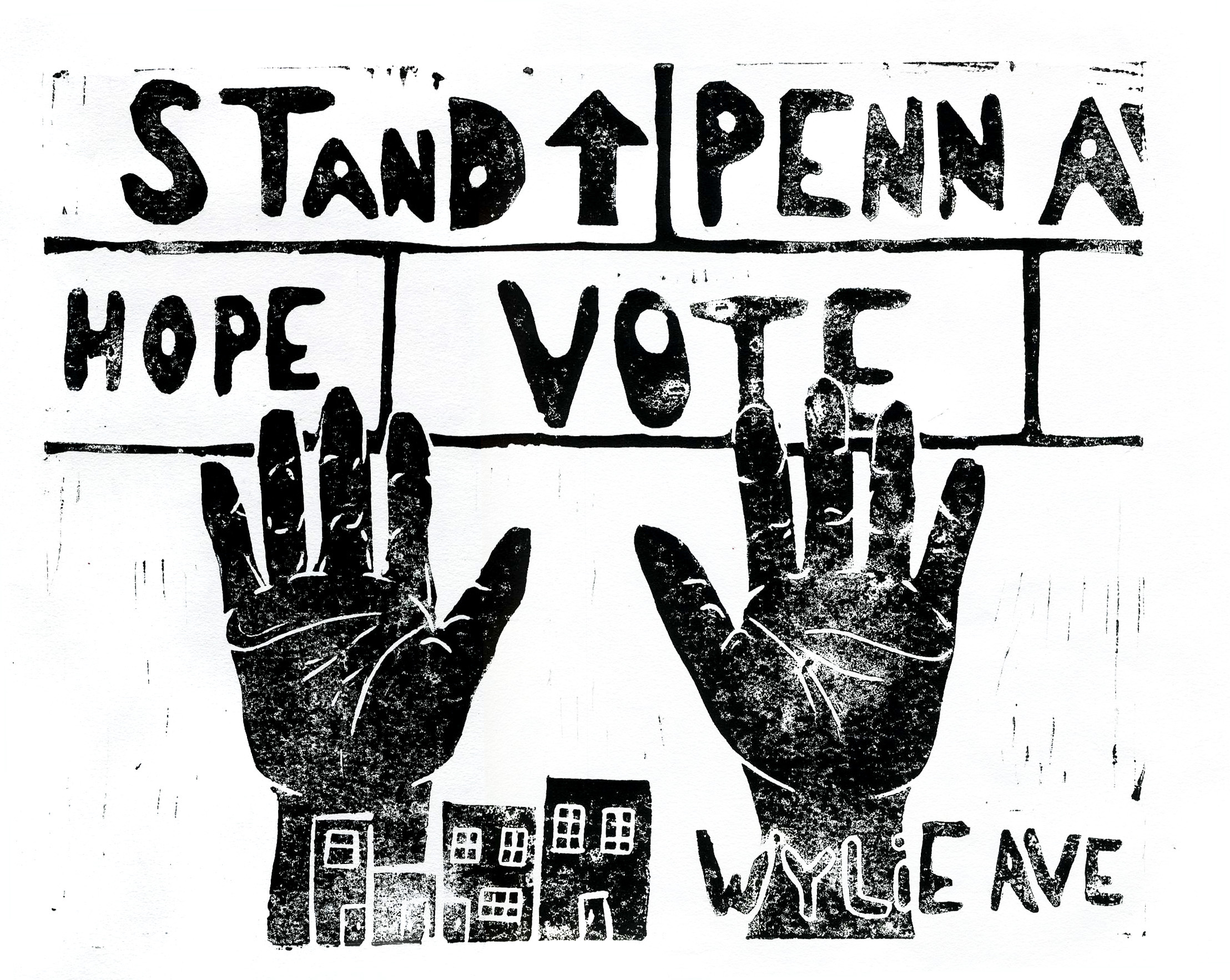
Hands on Wylie Avenue (Illustration by LaShawn Parks)
Sala Udin spent the early months of 1972 at the federal prison in Lewisburg, walking the yard with bank robbers and drug dealers. Guys like Raymond Jackson. Jackson owned “Sugar Ray’s” bar on Centre Avenue and was one of Pittsburgh’s most notorious drug dealers.
Jackson was a violent man with a short temper. Guards feared him. For Sala, Jackson was protection -- both were Pittsburghers, and this meant something in Lewisburg. So did Sala’s status as a militant civil rights leader. Pittsburgh convicts who knew of his work surrounded him and offered a level of security in an eerie, gothic prison filled with criminals like mobster John Gotti.
Sala was immediately eligible for parole, but he’d have to wait months for a hearing. During that time, he had to stay out of trouble. No fights, no escape attempts, no mouthing off to guards.
So Sala stuck with the Pittsburgh crew and bided his time. He lifted weights, played basketball. Meanwhile, civil rights workers like Jessie Jackson and Lewis Stokes wrote letters on his behalf, seeking his release. Sala needed to get back to Pittsburgh as soon as possible, to return to the work he’d started in his ailing hometown, where poison flowed through the streets.
In the late 1960s, narcotics sucked life from all levels of the Hill District. Sala could see it on street corners, in stores, in pool rooms and clubs -- addicts leaning against walls, their heads nodding, drooping down, junkies nearly falling before jerking upright.
Heroin had always been in the Hill, but in the old days users were mostly musicians, hipsters and hustlers. Folks on the fringes. No longer. Addicts now were brothers and sisters, parents, uncles, the girl who sat next to you in high school, your former boss.
Sala grew alarmed. He and other militant young activists embarked on an independent and unofficial operation called “Off the Pusher.” They roamed the streets, searching for drug peddlers. Sala and his colleagues beat those they found, took their money, flushed their drugs.
And it worked for a while. Then dealers pushed back. The Pittsburgh militants quickly learned they weren’t fighting a ragtag collection of individuals but an organization of armed dealers. Sala and his colleagues became targets. There were, in Sala’s words, getting their asses kicked.
They needed another plan, a less violent method of battling addiction. They found it in New York, at an organization called Phoenix House. Former addicts there stayed sober in a very structured environment that relied on work and encounter sessions. Maybe it could work in Pittsburgh.
So Sala and a friend, Jake Milliones, spent a summer at Phoenix House, learning to set up and operate what was called a “therapeutic community.”

Sala, after changing his name, explores his African roots. (© 2006 Charles “Teenie” Harris Archive, Carnegie Museum of Art, Pittsburgh)
Next, they needed a building. Someplace in the Hill. The best option was a three-story brick structure squeezed between a basketball court and the Zone 2 police station on Centre Avenue. The place was notorious as a shooting gallery filled with stoned out junkies.
One day Sala and Jake and a few others from an organization called the Afro American Institute marched into the building and announced, “We’re here now, we’re going to turn this into a treatment center.” Junkies retreated to the sidewalk outside and glumly watched while a determined group of young men took measure of the building.
It was a dump. Sala stepped around feces, rancid food, rotting animal carcases, used needles. The stench was nearly unbearable. Making the space usable was going to take time.
Sala and Jake recruited a few former addicts and went to work, filling garbage bags, hauling them out to the street, hitting up neighborhood stores for flooring, paint, plumbing and electrical supplies. They started on the first floor, at the front of the building, and worked their way back, room by room.
They named the residential drug treatment program Ile Elegba, after an African god who stood at the crossroads between life and death. Once accepted into the program, addicts adhered to a rigid schedule in a drug-free environment. They rose early, made beds, ate breakfast, then went to work, remodeling and then maintaining the building. Those who broke rules received as punishment even more gruelling work -- cleaning floors with a toothbrush, for example.
Key to the program were “encounter sessions” -- loosely structured group therapy conducted three times each week. In these sessions, residents discussed their frustrations and were confronted when they broke rules.
The sessions often became raucous, no-holds-barred events -- physical violence was a no-no, but individuals were verbally “beaten up,” their progress challenged and criticized by other residents. It was all part of an effort to prepare former addicts for a return to the community.
Sala, serving as the program’s executive director, felt it was important to bring an awareness of politics and policy to Ile Elegba’s residents. They celebrated the birthdays of Martin Luther King Jr. and Malcolm X and participated in Civil Rights demonstrations and marches. Leaders at Ile Elegba were careful to discuss with residents the issues being addressed and what they meant community.
The city eventually assumed ownership of the building on Centre Avenue and sold it to Ile Elegba Inc. After months of work, a place once reeking of death and decay took on new life. It was a massive reconstruction project -- the building now had new plumbing, wiring and heat. The work was completed largely by those who once seemed destined to accomplish nothing more than plunging needles into their flesh and nodding unsteadily on street corners.
During the late 60s and early 70s, Sala often found himself assuming a different identity -- on stage. He became a lead actor in Black Horizons Theatre, a repertory group formed by two young Pittsburgh poets, August Wilson and Rob Penny.
Wilson was a friend of Sala’s from grade school. He and Penny, like many activists and artists at the time, saw theatre as a powerful teaching tool, a vehicle through which a community could be organized around progressive ideas.
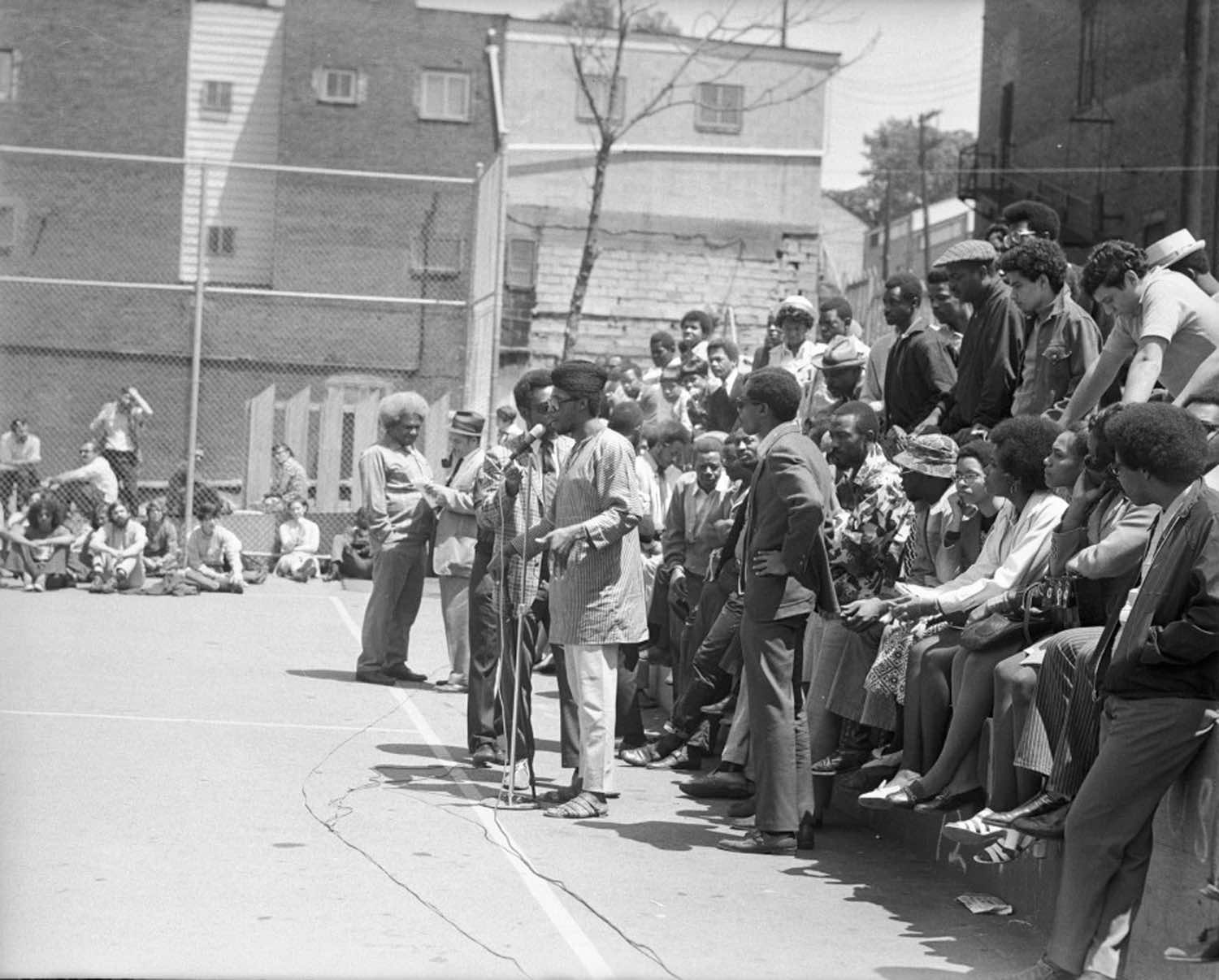
Sala speaks to a crowd on an outdoor basketball court next to Ile Elegba on Centre Avenue in the early 1970s. (© 2006 Charles “Teenie” Harris Archive, Carnegie Museum of Art, Pittsburgh)
Members of the company took care of everything from building sets to managing stage lighting to acting. Funding came from members’ own pockets. Sala’s role as a lead actor was due largely to his status as a community organizer.
Black Horizon’s plays were staged at a local elementary school because the principal there allowed the group to use the auditorium. They were popular affairs, but not professional. You never knew when the set would come crashing down or some other disaster would interrupt the performance.
By the mid 1970s, Black Horizons Theatre had disbanded (its legacy continued in 1974 when Vernell Lillie founded Kuntu Repertory Theatre), but Sala’s connection to his childhood pal August Wilson would remain.
Seven months into his prison sentence, Sala finally faced a parole board. A number of people had spoken out on his behalf, noted his work in the community and his role in establishing and leading Ile Elegba. The charges against Sala did not warrant continued incarceration, they argued. The board agreed, and Sala returned to Pittsburgh to resume his role as head of Ile Elegba.
His life soon became more complex. In 1973 he married Tamanika McMashaux and a year later the couple brought into the world a set of twins, sons Salim and Bomani. A third son Patrice was born in 1975.
Sala and Tamanika were both heavily involved in the civil rights movement and took their young children with them to rallies and meetings -- a common practice among activists. But Sala struggled to balance home life with his work. He was not, he’d admit years later, spending enough time with his family. Taking the kids to meetings and other movement events was a poor substitute. That’s work time, he later realized, not family time.
By 1977, Sala and Tamanika had split. Tamanika was raising the couple’s three young sons in a Hill District housing project; Sala had his work at Ile Elegba and was involved in other movement activities. At this time, questions began haunting him. What are you going to do with the rest of your life? What have you done with the years you’ve already lived? Sala had been involved in the movement since that moment in the summer of 1965 when he stepped on a bus headed to Durant, Miss. What did all of that effort add up to?
Now, that movement was changing, organizations were splintering. And his personal life had changed. Sala was asking, Who am I?
Sala figured he was tired, he needed a break, needed to step away from taking a lead role in so many projects. Only then could he take stock of his life. So he resigned from every organization he was involved with except Ile Elegba.
What are you going to do with the rest of your life? What have you done with the years you’ve already lived?
It didn’t work. The phone continued to ring, folks still sought Sala’s help in organizing boycotts or staging sit-ins or dealing with an issue at a local school. Sala figured the only way to separate himself from his responsibilities as an organizer was to leave the city.
Doing so would mean leaving his three young sons, the drug treatment program he’d headed for more than a dozen years, and the city of his birth. But he believed strongly that he needed the break -- from Pittsburgh, the ringing phone, the organizing, the problems in his personal life.
In the Spring of ‘83, he contacted Gerald Stephenson, a friend and former addict who’d graduated from the Ile Elegba program.
Want to go west? Sala asked.
I don’t have any money, Stephenson said. I’ve got some antiques I can sell along the way.
OK, Sala said, let’s do it.
Sala loaded up a raggedy old pickup truck with his belongings, which consisted mostly of books, then packed in Stephenson’s antiques, and the two headed west. The journey wouldn’t end until they’d reached an ocean.
Previous Chapter
Chapter 6
LEWISBURG FEDERAL PENITENTIARY
Continue Reading
Chapter 8
PITTSBURGH CITY COUNCIL
Chapter 8
by Steve Mellon

Councilman Udin (Student Illustration by Cole Gradeck)
Sala Udin drove a rental car from Pittsburgh to Detroit on a cloudy and unusually cool August day in 1992. Checked into a hotel, unpacked his bags. Sala was accustomed to sleeping in places of crisp yet unfamiliar bed sheets. Since moving west, first to Los Angeles and then San Francisco, Sala had continued to engage in the nation’s long and tragic struggle with substance abuse, working with drug treatment organizations in cities across the country.
Years earlier he had uprooted himself from Pittsburgh but maintained his hometown contacts. Sala tried to be a long-distance father, making frequent trips back to Pittsburgh, bringing his kids to California for summer visits. But Bomani, Salim and Patrice Howze were growing up without the daily presence of their father.
Then cancer invaded the body of Sala’s mother, Mary Howze. Sala wanted to be near in her moment of pain and sickness. His work was such that it did not matter where he was staying, so long as it was close to an airport and an interstate highway. So he began spending more and more time in Pittsburgh.
In Detroit, Sala settled into a routine. He picked up the hotel phone, dialed a number, listened to phone messages. That’s how he got the news. Delivered by a familiar voice, that of his sister, in a room strange to him.
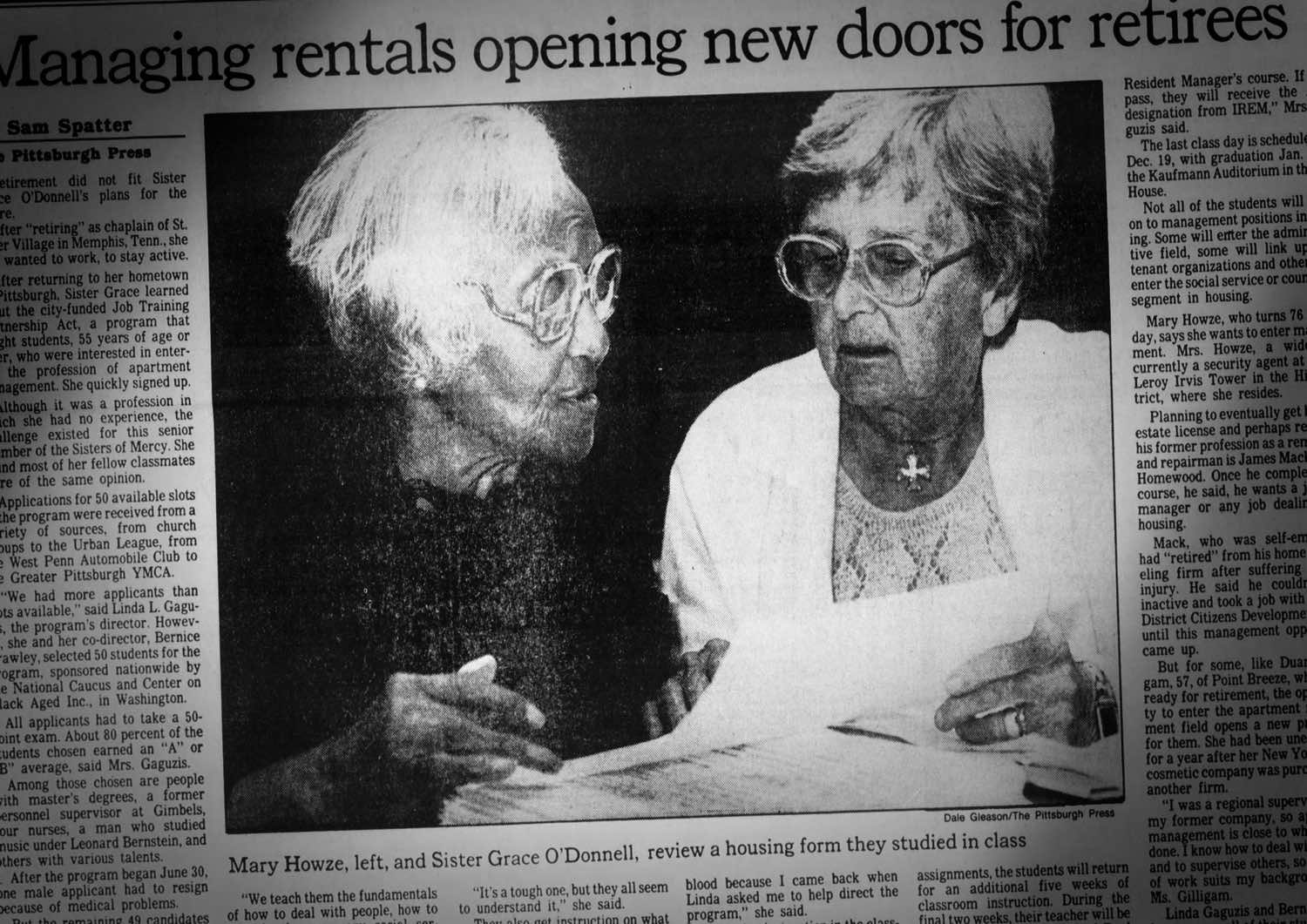
Mary Howze (left) in a 1986 article in The Pittsburgh Press.
For the second time in his life, Sala traveled home to bury a parent.
Mary Howze always seemed to be working two jobs, as a cleaning lady at Holy Trinity in the Hill District or the Enright Theater in East Liberty, and as a housekeeper for Jewish families in Squirrel Hill. Sometimes she’d come home bearing food she’d received as gifts -- Matzo balls, gefilte fish. Her children did not always savor these foods, but since they were offered as gifts Mary expected her brood to eat. Mary made certain her young children were respectful, fed, dressed, sent off to school with completed homework.
Married life could be difficult for Mary. William Howze was a hardworking, hard-drinking man, and as his health declined near the end of his life, living with him could be hell. But Mary, devoutly religious, was patient when William wasn’t. She seemed to understand what most tormented her husband: A chronic, painful illness had robbed him of his identity as a man of heavy labor, a provider.
She’d been patient, as well, with her seventh child, stubborn as his father. Sala had made decisions that certainly pained her. He’d fought with his father, quit school, fled from home, traveled south against her wishes, discarded the name she’d given him. Still, Mary always supported him, even when so many others did not. Now, as Sala drove from Detroit to Pittsburgh, he asked himself, “How am I going to live in a world that doesn’t include mama?”
Less than six months after burying his mother, Sala suffered another loss -- the death of friend Jake Milliones.
Sala and Jake had worked together for years, at the Pittsburgh Afro American Institute and at Ile Elegba.
Jake entered politics in the 1980s, serving on the city’s school board, then winning a city council seat. A few years into his first term on council, Jake asked Sala to organize and run his city hall office. At the time, Sala worked as a traveling consultant, but the job gave him enough flexibility to accept a part-time position as his friend’s chief of staff.
Then suddenly Milliones was gone, felled by a heart attack in January 1993. The city had lost a strong and progressive voice on council. A small group of Jake’s supporters urged Sala to fill the void. Sala did not think of himself as a politician.
But Jake’s supporters persisted, and so Sala joined a crowded field of eight candidates. The district faced a lot of problems. Chief among them, Sala said at the time, was the “supersaturation of drug-trafficking and gun-trafficking and the subsequent violence.”
Election Day arrived and Sala was optimistic. He and several supporters squeezed into a packed room in a tiny Herron Avenue apartment that served as campaign headquarters. May 18, 1993, was was a big day in Pittsburgh. The city was on the verge of change. Residents from Brighton Heights to Carrick to Windgap made their way to churches and fire halls and community centers to cast votes for a new mayor -- the grandmotherly Sophie Masloff had decided against seeking another term -- and to fill seats on city council.
Sala and his supporters gathered around a TV to watch results. News anchors announced that a state legislator named Tom Murphy was the Democratic nominee for mayor.
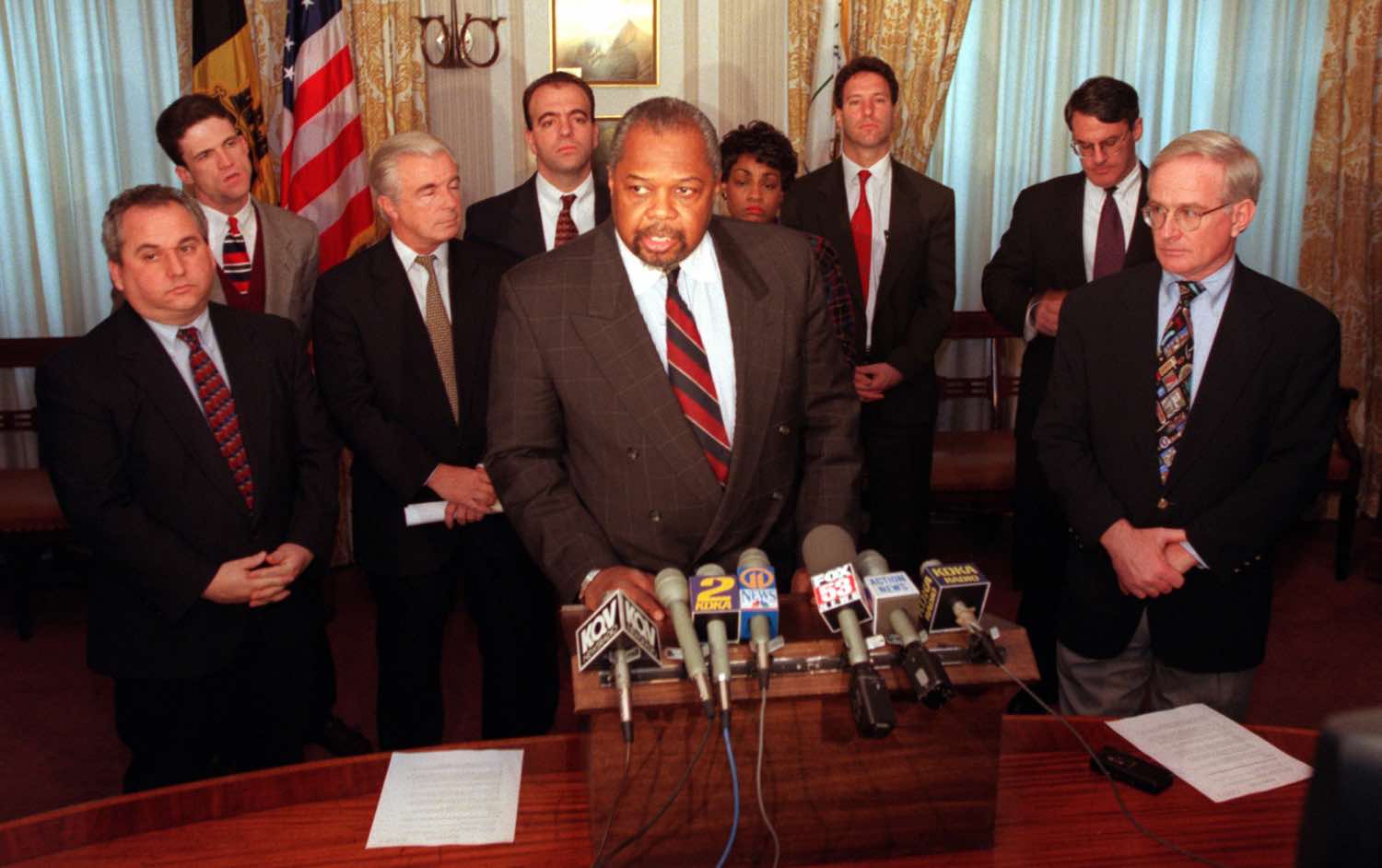
Sala is flanked by fellow City Council members and mayor Tom Murphy (right) during a 1997 press conference. (John Beale/Post-Gazette)
For Sala, the news was not so good.
As it became clear Sala would lose, supporters drifted away. Finally, Sala was alone, sitting on the floor in an empty room bathed in the glow of a TV set that served up regular reminders of his defeat. Another loss. Another painful, depressing experience. They were mounting.
At one point, a friend and mentor entered the room. He reached down, Sala thought, to shake hands. Instead, the man grabbed Sala’s wrist and pulled him to his feet.
“Please, don’t ever let me see you sitting down on the floor after an election like this,” he said. “It’s not your place.”
The experience of being physically lifted, both from an awkward position on the floor and from what could have been depression, was a new and powerful one for Sala. For years he’d felt like the one reaching down, pulling up those suffering their own losses.
Christopher Smith, the man who’d won Jake’s old seat, died in office in December 1994. Sala was urged to run in a special election. He agreed, but only if he received backing by those who’d opposed him earlier. On May 15, 1995, Sala won the seat once held by his pal.
Sala served on city council for a decade, and the highlight of that tenure, he’d say years later, came on a Monday afternoon in early August 1997. Council chambers that day was packed with those anticipating an historic moment, the culmination of nearly two years of proposals, hearings, fights, losses, a court challenge and a referendum. In the end, it came down to a 32-second vote. Sala lept to his feet and pumped his first. Cheers erupted in the stuffy room, with its wood paneled walls and heavy gold drapes. People joyfully waved neon yellow signs reading “Yes.” A few wept.
Pittsburgh had established a panel of civilians who would investigate complaints against city police.
Not everyone was happy. Marshall “Smokey” Hynes, head of the police union, promised a lawsuit. “You can take that to the bank,” he said.
Sala proposed the board in the wake of an incident that remained in the news for months and drew into sharp focus the divide between police and the communities they patrol, particularly the African American community.
Jonny Gammage, a black businessman and cousin of Steeler Ray Seals, died during a traffic stop just inside the city limits on the night of Oct. 12, 1995. Authorities determined Gammage suffocated after pressure was applied to his neck and chest. Charges were dropped against two white suburban officers after a pair of mistrials -- in one, the jury deadlocked 11-1 with the holdout the lone black on the panel. A third officer was found not guilty by an all-white jury.
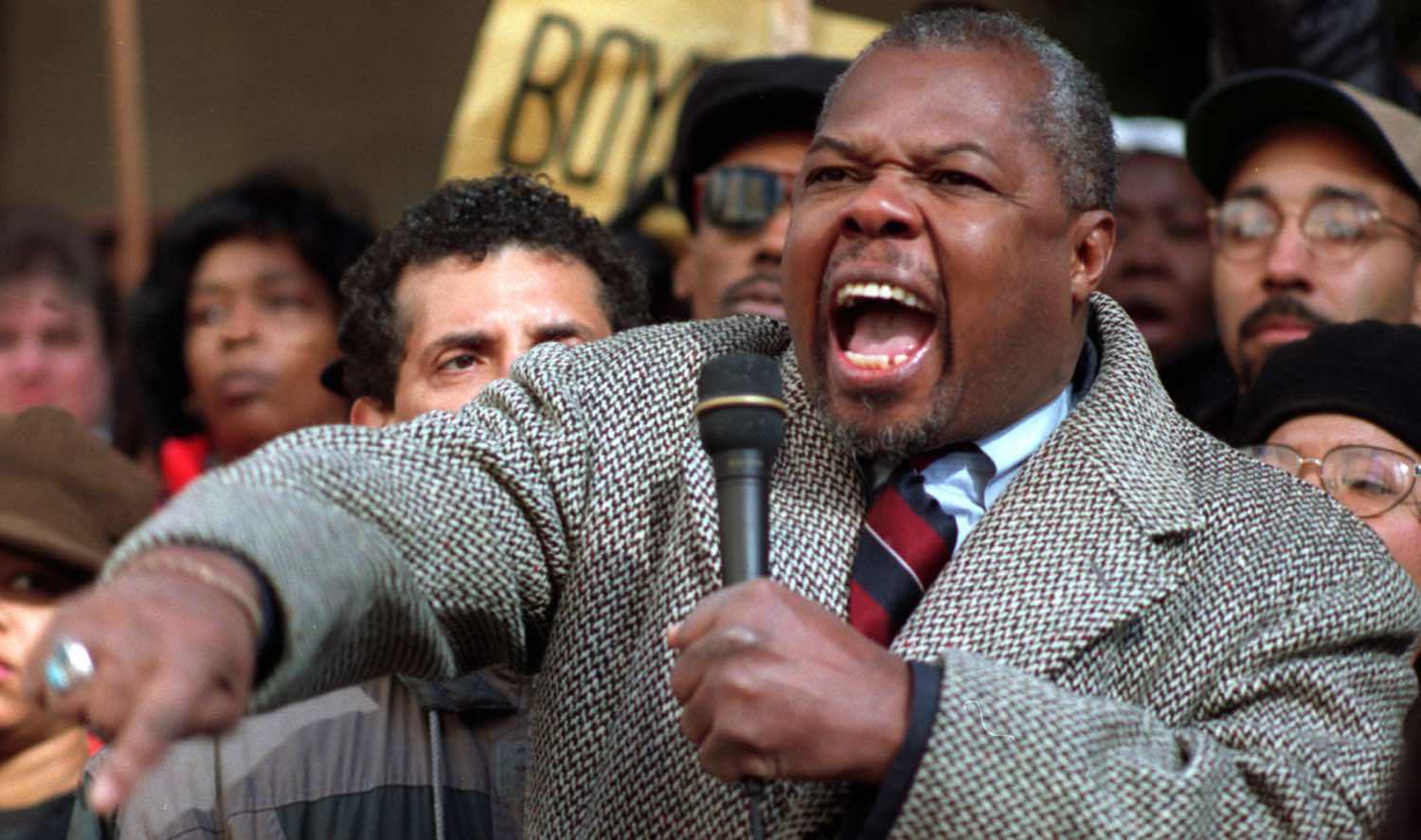
Sala at a rally following the death of Jonny Gammage. (Annie O’Neill/Post-Gazette)
Despite widespread outrage over Gammage’s death, Sala’s proposal drew powerful opposition that included the mayor, the police union and some of Sala’s colleagues on council. By the summer of 1996, the police community was focusing its fury on Sala. A crowd roundly jeered when Sala stepped up to a microphone during a July 3rd rally for an injured city police officer named John Wilbur. Most of the 2,500 who packed Market Square that day were regional police officers and their families. Sala represented the enemy. Still, he pressed on with his remarks.
“Just as violence gets us nowhere, so, too, does denial,” he said. “There is a problem out there. Let us support our fine public servants by figuring out how to solve it. And by showing we have the will and the leadership to rescue our city.”
Failure arrived three months later. In October, city council voted 5-4 against legislation that would have established the board. Sala and colleagues Jim Ferlo, Dan Cohen and Valerie McDonald vowed to continue the fight.
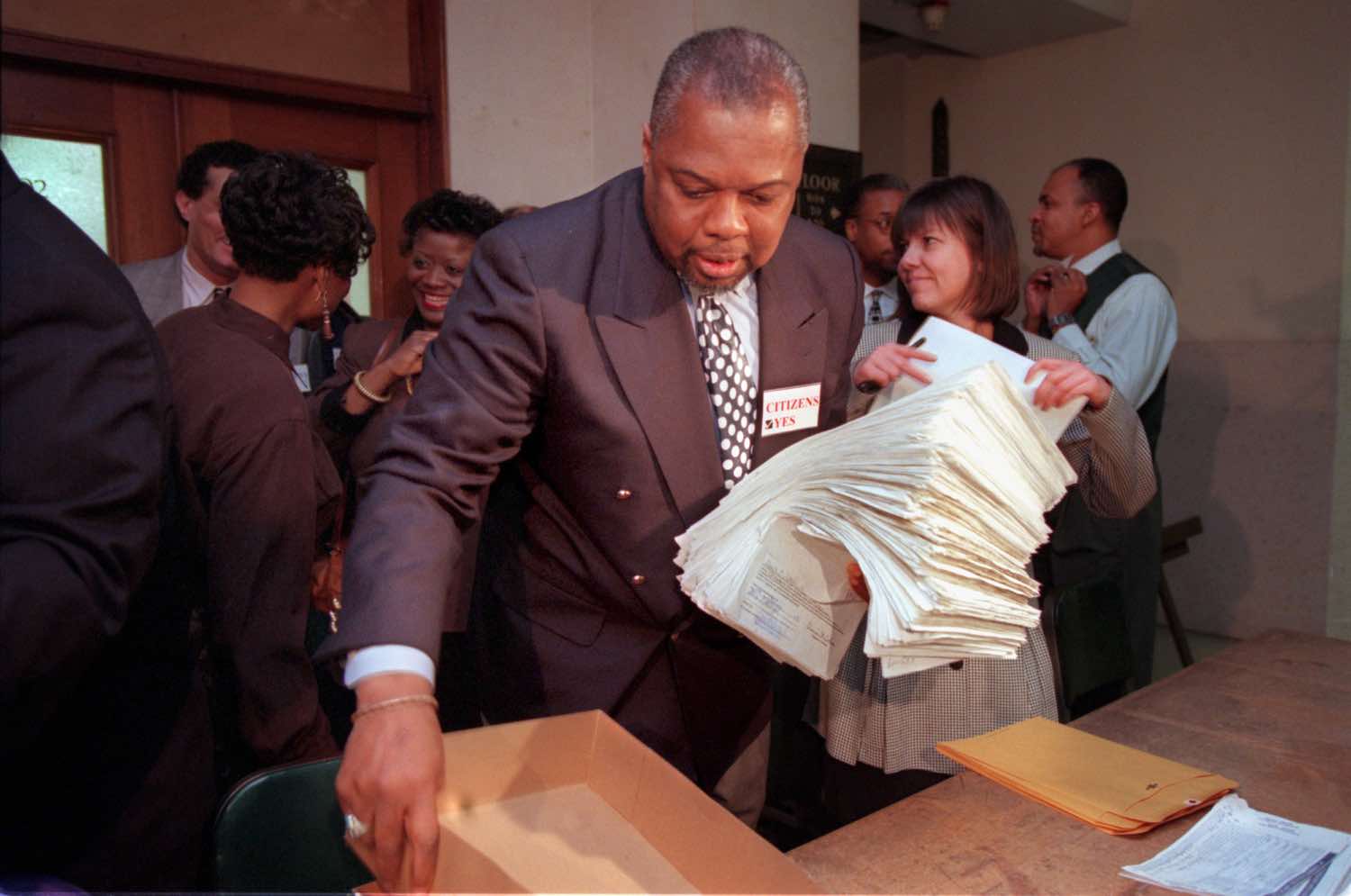
Sala submits petitions for a Citizens Review Board. (Robin Rombach/Post-Gazette)
At one point, Sala was told by fellow council members fearful of the city’s police union, “Look man, these guys, they don’t play. They may not be able to take you out, because you’ve got the black community supporting you, and you’re doing what they want you to do. But if I come out against the police, and the police tell my constitutions that I’m anti-police, I’m dead [politically].”
So Sala and other proponents collected more than 17,000 signatures to force a referendum. And on May 20, 1997, voters said “yes” to the review panel by a 16-point margin, leading to the bill passed by city council and Sala’s fist-pumping moment.
Formation of the board wasn’t Sala’s only accomplishment -- he fought for increased minority and female hiring in city contracts, and for the establishment of Freedom Corner, the monument to Pittsburgh’s Civil Rights veterans. He won newspaper endorsements for “being a dependable voice of moderation on a sometimes fractured council.” There was controversy, such as a flare-up over up to $800 in unpaid parking tickets.

At the Crawford Grill, Sala celebrates after winning a re-election bid. (Steve Mellon/Post-Gazette)
During his second term, Sala considered a run for mayor, but soon found support wasn’t there -- the city wasn’t ready for a black mayor, he figured, especially one who had been a loud and persistent “voice for the oppressed.”
So he decided against the idea. But by then it was too late. In his words, he’d “taken his eye off the ball.”
Previous Chapter
Chapter 7
CALIFORNIA-BOUND
Continue Reading
Chapter 9
Macedonia Baptist Church, Pittsburgh
Chapter 9
by Steve Mellon
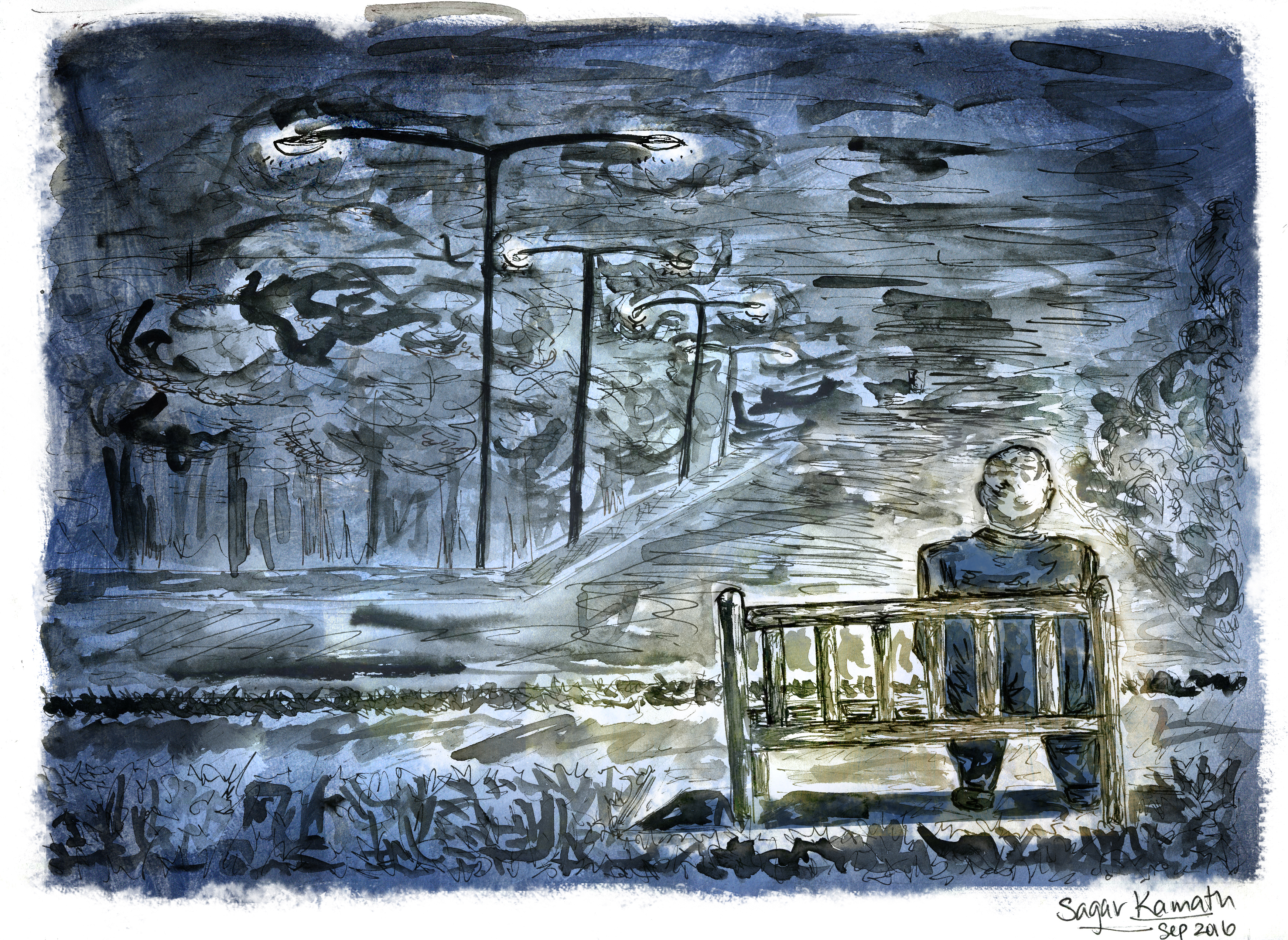
Sala in the brutal year 2005 (Illustration by Sagar Kamath)
You can picture the father trying to walk with the small boy clinging to his leg, the father hoisting his giggling son, setting him back down. A heavy step.
That’s how Sala Udin remembers his son Patrice as a child. Clingy. A hugger. He yearned to touch. Crossing the street, he would hold his father’s hand. Unlike his brothers, Patrice would not let go when he safely reached the other side.
Those are the pleasant recollections of the son.
And in Sala’s memory they must share space with jagged shards that continue to cut after all these years:
A phone call.
A trip to Downtown on a Sunday morning, thinking and hoping this was all a mistake, that the victim is someone who just happens to look like Patrice. The unzipping of a body bag and the moment false hope collapses under the weight of truth and down comes the grief, crushing all who are there — mother Tamanika, brother Bomani, and the father, Sala.
The year 2005 delivered no mercy. In May, Sala lost the city council seat he had held for a decade to a former member of his staff. Tonya Payne had successfully painted Sala as too close to Mayor Tom Murphy — he was “Murphy’s Boy,” Payne’s supporters said. The label proved politically deadly. Murphy was unpopular in the African-American community. Sala lost to Payne by 203 votes.
Then, on Oct. 2, Sala’s friend August Wilson died of cancer. August had left Pittsburgh to become one of America’s most important playwrights, so a number of Broadway actors and directors attended his funeral at Soldiers and Sailors Memorial Hall and Museum on a cloudy Saturday. Sala stood before 400 mourners and recalled his days with August in the Hill. He said that his friend “gave us the reality of where we’ve been and how we got there.” Trumpeter Wynton Marsalis closed out the service with a haunting version of “Danny Boy.”
Less than 24 hours later, Sala was heading to Downtown to identify the body of his youngest son.
Patrice was born Nov. 19, 1975, a year after his twin brothers, Salim and Bomani.
“He had to find his way and his identity in the shadow of these twins,” Sala said. “Patrice was very close to them, but I think he always had a difficult time trying to be seen and recognized and given an identity in their shadow. I think that was a difficult task for him.”
After moving to California, Sala knew Patrice was having problems. He heard the frustration in Tamanika’s telephone voice as Patrice became a rebellious teen.
By the time Sala returned to Pittsburgh in the early 1990s, Patrice had entered high school. He found a place for himself in sports. As a junior, he was listed as one of the Perry High School football team’s top newcomers. He was popular among students, well-liked by coaches.
“He had arrived socially in terms of his own identity and station in life,” Sala said. But the more attention and praise Patrice received, the more defiant he became. He skipped school, his grades plummeted. He had decided, Sala said, that “the straight life was not interesting.”
Sala moved into a rented house on Herron Avenue. Patrice moved in with him. It was a difficult time. Sala tried, and failed, to control his son’s behavior.
Sala heard rumors: Patrice was dealing crack. Patrice denied it. Father and son clashed. Patrice ran away from home, dropped out of school. Sala would see him on the street, give him long lectures. Words had no effect.
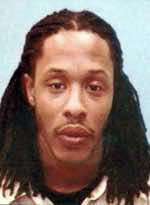
Patrice Howze
News stories later described Patrice’s aliases — Michael Darby, Michael Harris, Antoine Williams, Michael Hennley, Michael Remington. He was arrested dozens of times, on drug charges, weapons violations, drunk driving and receiving stolen property.
He would show up at family gatherings, Thanksgiving dinners, birthday parties, but he did not stay long.
“Whenever we’d take pictures at family affairs, the one person who would never smile was Patrice,” Sala said. “He wanted to give that hard look, maybe flash a sign.”
Patrice took a job at an East Hills BP station in 2004. The night manager there would remember him as a quiet and respectful man.
“He was cautious and he wanted to survive and live,” the manager said in a newspaper story. “He realized that being a black man in our community was dangerous.”
In the cool, early morning darkness of Sunday, Oct. 9, 2005, police responding to a report of gunfire peered into the woods and brush framing a mundane section of Centre Avenue and saw glowing red taillights. They investigated further and discovered a wrecked Chevrolet Monte Carlo, it’s motor still chugging.
Behind the wheel slumped Patrice Howze. Three bullet wounds in his torso. He was 29 years old. The young man had tried to drive away after being mortally wounded. He didn’t get far.
Police scooped several 9 mm casings off the cracked asphalt, looked in vain for the killer.
Patrice would have been just another of the 6,000 black men meeting a violent end in the U.S. in 2005, another unfortunate member of a community struggling with poverty, drugs, guns and death. But he was Sala’s son, so the story of his killing was front-page news.
More than 700 people squeezed into Macedonia Baptist Church for the funeral. Among them were friends and politicians like Mayor Tom Murphy, Allegheny County Chief Executive Dan Onorato and Esther Bush of the Pittsburgh Urban League. Workers in aprons came upstairs from the church kitchen.
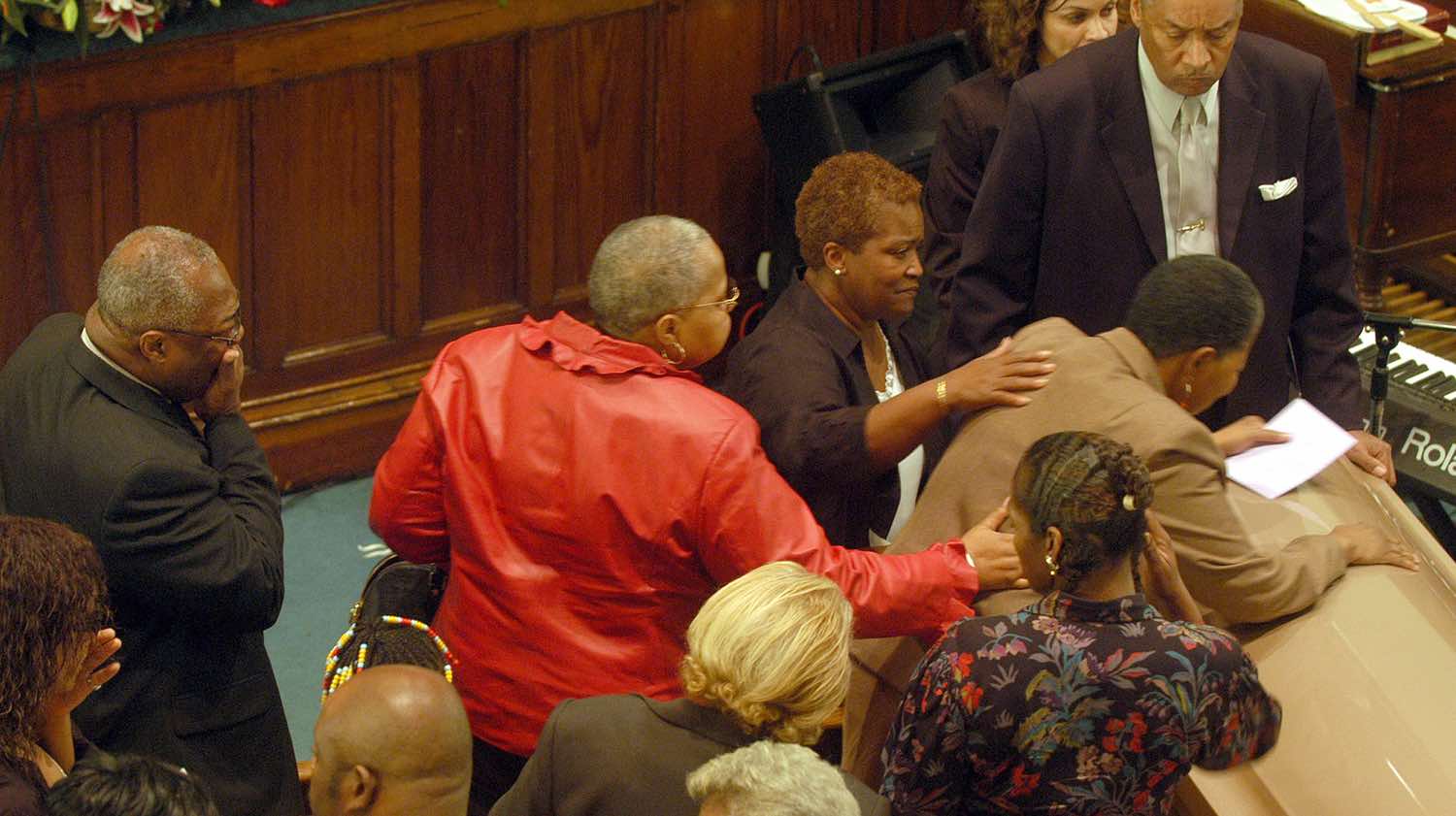
Tamanika Howze is comforted by friends and relatives as she leans onto the casket of her son Patrice. At left is Sala. (Steve Mellon/Post-Gazette)
Bomani remembered Trice, as he was known to family, for his love of grape Kool-Aid and popcorn and for playing in the spray of an open fire hydrant on hot summer days. Salim said his younger brother was a poet with a good heart, a realist.
Patrice’s grieving mother Tamanika Howze was praised as a strong and loving single parent raising not only her children but also a community of children, a woman who dreamed of getting her kids out of a housing project awash in crack and violence.
At one point in the service, mourners sat quietly and listened to a recording of “Dear Mama,” Tupac Shakur’s tribute to a single mother struggling alone to raise a rebellious son. “I finally understand for a woman it ain't easy tryin’ to raise a man.” Words of love and regret and a yearning for understanding echoed through the packed sanctuary.
Then, in verse two, “I was lookin’ for a father he was gone. I hung around with the thugs, and even though they sold drugs, they showed a young brother love.”
The music faded and mourners, including Sala, stood and applauded Tamanika’s efforts.
After the eulogies and the preaching, family members gathered near the front of the sanctuary to say goodbye to Patrice. Tamanika laid her head on on her son’s closed casket and wept. Standing behind her was Sala, already wrestling with questions about his role in his son’s choices.
Sala had spent decades fighting for the poor and the voiceless, and pushing back against the poisons and violence and death squatting defiantly in so many neighborhoods. Maybe he should have spent more of that time with Bomani, Salim and Patrice. Maybe that’s where his presence was needed most, with the young boy who continued to hold his father’s hand, even after safely crossing a street.
Now, as Sala filed past his son’s casket, he was left only with questions that would haunt him for years. “Did my divorce and moving to California contribute to my son’s death? Was Patrice in the streets looking for his father?”
Previous Chapter
Chapter 8
PITTSBURGH CITY COUNCIL
Continue Reading
Chapter 10
CENTRE AVENUE, HILL DISTRICT
Chapter 10
by Steve Mellon

August and Sala (Illustration by Eryn Oberts)
One day in 1982, Sala Udin and his friend August Wilson huddled in a tiny restaurant in the 1700 block of Centre Avenue and, while they talked, filled an ashtray with crushed used-up cigarettes. Outside, young men loitered on the street corner or sat on the concrete stoops of boarded-up buildings. Sometimes people walked into the street to talk to friends driving past, stopping traffic. Music thumped from boom boxes.
The restaurant was a greasy place, its air thick with the smell of fried food, coffee and cigarette smoke. Inside were three or four small wobbly tables. Nothing about it stood out except that it was owned by a man with a reputation for despising people. He refused to give his restaurant a name. At one point, he had taped a handwritten cardboard sign to a window. “Pan Fried Fish,” it read. So that’s what people called the joint.
Pan Fried Fish had become a regular hangout for Sala and August. The two men would sit for hours, talking, drinking coffee and smoking. They had known each other for decades, and they shared a love of theater and the Hill District. August no longer lived in Pittsburgh — his home was now in St. Paul, Minn., where the poet had begun writing plays, with Pittsburgh as a setting and an anchor. But he made frequent trips to his hometown.

Hanging out on Centre Avenue in the early 1980s. (Post-Gazette)
His characters were like those folks just outside the restaurant door — people who struggled through daily life, who fought to keep their relationships from imploding, people who gained little from a lifetime of hard work, who gossiped and drank and had difficulty with forgiveness. They ate at places like Pan Fried Fish and wondered what had become of their lives.
August was always talking about new plays and characters. He sipped coffee and described to Sala one of his most recent works. The title was “Jitney.”
The word meant something to Sala. Like his father, he had worked as a jitney driver when he needed extra cash. Jitneys were essential to the neighborhood.
“I was thinking of you in the lead role,” August told Sala.
At “Jitney’s” heart is a bitter conflict between a stern father and his grown son. The father had worked hard, sweated out his life, chewing and then swallowing his anger and pride every time he was humiliated. He did this for his son so the son could have a roof over his head, food to eat. So the son could one day rise above the poverty and the dashed dreams littering the neighborhood. The boy would be somebody. Just wait and see.

August Wilson in the late 1970s. (Post-Gazette)
But the son had his own ideas about his life. He hurt others, hurt himself and the father; crushed the father’s hopes, in fact. The father decided his son would always be a bum.
Sala held complex memories of his own father: Tipsy nights when William Howze gave his young son hugs; sober days when the father assumed an almost military bearing and barked orders at his kids; brutal confrontations as a teenager; the sudden and shocking news of the father’s death; the cold and painful trip back to Pittsburgh to attend a funeral.
Sala heard echoes of those experiences in “Jitney.”
“You are my son,” Becker roars at Booster at the end of act one. “I helped bring you into this world. But from this moment on … I’m calling the deal off. You ain’t nothing to me, boy. You just another nigger.”
How does a father/son relationship survive such language? “Jitney” gives a nuanced, unclear answer, one that certainly resonated with many in the Hill.
The play opened in October 1982 on a stage built in a church annex in the city’s Oakland neighborhood. Legend says that August Wilson and his mother traveled to the theater in a jitney. Sala, not yet 40, grayed his hair and wore spectacles to look the role of the father, Becker.
Crowds were sparse the first few nights. Then, on Nov. 3, The Pittsburgh Press published a review.
“The production,” it read, “is noteworthy in many ways: as a world premiere, as the work of a playwright who grew up on the Hill, and as a showcase for a talented all-black cast.”
Sala’s performance as Becker, the review read, “knits everything together.”
Those who saw the play told their friends. Perhaps for the first time, many Pittsburghers listened to voices from a previously unheard and invisible community that throbbed with life a little more than half a mile from Downtown.
“You look up one day and all you got left is what you ain’t spent,” Becker muses in act one. “Every day cost you something, and you don’t all the time realize it.”
Sala recognized something of his life in August’s words. Becker was like so many fathers in the Hill. Stern. Unyielding with those he loved. Weary from decades of work that seemed to bear so little fruit.
Sala was trying to sort out his own life, so after the show’s run, he packed up his things and headed west, leaving his family, his work at the Pittsburgh drug rehabilitation program Ile Elegba.
August continued writing and rewriting. He would soon emerge as one of the country’s most acclaimed and important playwrights. “Fences” premiered on Broadway and won a Pulitzer Prize and a Tony Award. “The Piano Lesson,” too, won a Pulitzer.
August’s most significant contribution is a series of 10 plays that chronicles the African-American experience, decade by decade, in the 20th century. Together, those plays are known as “The Pittsburgh Cycle,” and all but one are set in the Hill. “Jitney,” the first to be produced, takes place in the 1970s.
By the spring of 2016, the jitney drivers who once operated out of that storefront on the 1700 block of Centre Avenue would have had a difficult time recognizing the street. The ancient storefronts had been demolished. The avenue was lined with trees and crisp, carefully landscaped housing units that would fit into any suburb.
Pan Fried Fish was long gone and would have failed to rate as even a greasy memory if not for that legendary meeting between old friends 34 years earlier. One of those men had helped the community realize its identity; the other had helped usher changes to the Hill.
August Wilson has been gone for more than a decade, yet on occasion he and Sala still share words, their voices becoming one to illuminate the stories of so many in Pittsburgh whose past includes unclear histories, who sometimes must shout to be heard, who yearn for redemption.
It happened once on a warm April evening in 2016, just past rush hour, in a sleek and modern building in the city’s Cultural District. The building stands largely through the efforts of Sala and several others, and it bears the name August Wilson Center for African American Culture.
On this night, Sala once again took the stage to play the role of Becker.
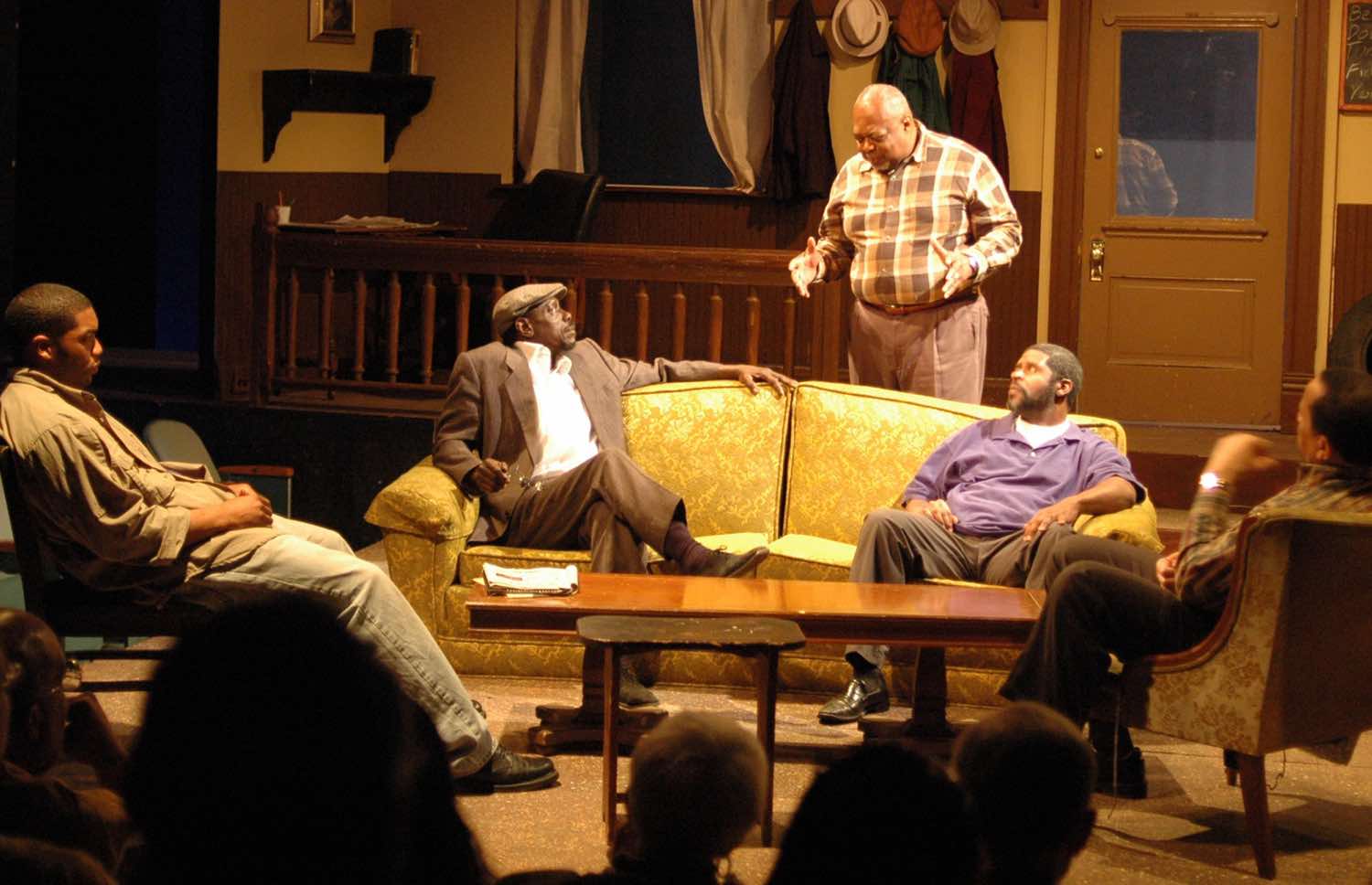
Sala again played the role of Becker in 2010. (Post-Gazette)
The set was spare — a couch, a few chairs, a doorway and a phone — for this was a reading of “Jitney,” not a full-blown production. But it was a special reading, and the crowd packed into the theater seemed to recognize it as such. Several minutes into the play, Sala made his entrance. Before he could utter his first line, Sala was greeted with applause.
Perhaps the applause was in recognition of Sala’s decades of activism in the community. Perhaps it was in recognition of his connection to the play and to the playwright, and the fact that the battles and losses, the victories and laughter, were experiences shared by a community that, despite the sleek building and the award winning plays, still struggles to be heard.
On stage, Becker roared at his son, “You could have been something.” The gossip Turnbo wouldn’t shut his mouth. Fielding slipped a bottle from his pocket and took a sip. Rena said to her man Youngblood, “You supposed to know what’s important to me like I’m supposed to know what’s important to you.”
At play’s end, Becker is gone, killed in a mill accident and Booster is robbed of a chance to resolve the differences with his father, face-to-face. It’s a heartbreaking and seemingly hopeless moment. In the final scene, the phone rings, Booster picks it up. “Car service,” he says.
Sala believes that’s a resolution. A confirmation by the son of the father’s role and importance in the community, one that’s worth recognizing and carrying on.
Like Booster, Sala lost his father before a dark chasm could be bridged. And he lost a son to the violence of Pittsburgh’s streets. These are burdens Sala carries still, as he contemplates new leadership roles in Pittsburgh. For years, the pain of Patrice’s murder kept him out of efforts to curb the violence that’s killing so many in his community. Maybe now is the time for that to change, he said one day in October 2016.
During his re-election campaigns, Sala made a habit of visiting Hill District stores, barber shops, beauty shops and bars. He would chat with people, drop off some of his literature. One of his stops was a bar called the Red Onion at the intersection of Webster Avenue and Kirkpatrick Street.
Sala could never win any votes at the Red Onion — his opponent had the place wrapped up. But he noticed a woman there, someone who seemed to have some authority over the place. Her name was Jacqueline Wells. She and her father owned the Red Onion.
Once the election was over, Sala stopped by again. “Why are you still coming around?” Jacqueline asked. “The election is over.”
“I just stopped by to have a beer,” he said. The two became friends, then started dating.
Sala and Jacqueline married in 2004. Now the couple live in a home on Iowa Street, in a residential section of the Hill District. Sala’s past is never far. In the spring and summer of 2016, movie crews could be seen a few blocks away, filming scenes for the movie version of August Wilson’s “Fences.”

Sala helps grandson Quincy Wells, 7, with 2nd grade math homework at Udin's Iowa Street home in 2016.
On some days, Sala sits in his basement office and ponders whether to delve further into the lives of the two sisters named Howze and their horrific deaths on the Shubuta Bridge in 1918. Who was the young woman named Maggie who pleaded and then fought for her life, even as her broken teeth and blood fell to the bridge deck? Are she and her sister Alma, and the children they were bearing, kin to Sala? Did the sisters bear a physical resemblance to anyone in Sala’s family?
Records of poor black families in the American South are difficult to find, if the records exist at all. Often, the information is contradictory. Some documents indicate William Howze lived in Hattiesburg, Miss., but a few years ago Sala talked to some people on the North Side whose families migrated from Shubuta. They knew about William Howze and his family. “They said, ‘Your father is from Shubuta,’” Sala said. “People from Shubuta always told people up north they were from Hattiesburg.” It made them seem less “country.”
Maybe it’s best so much remains a mystery. Sometimes Sala thinks learning details of the Howze sisters’ lives would only mean more pain. Still, he mentions the sisters often when discussing his genealogy.
He understands his life was, in many ways, shaped by the threat of violence in the Jim Crow South. He was raised in a northern city by a father whose early years were spent in places where blacks were intimidated or beaten for breaking “rules” or customs. William Howze became a hard man. A tough man. He wanted his son to be tough, too. To be a survivor.
Sala didn’t understand this when he was young. He bristled at his father’s rules, fought and argued with the old man. Eventually, Sala figured it out, but it was too late for reconciliation. Death arrived before father and son could come to an understanding, before each could articulate a love and appreciation for the other.
Sala hears echoes of his father in his own life. He hears those same echoes in “Jitney.” They’re reverberations recognized by those who have found themselves displaced, who have yearned for an identity in a city that often ignores them. People who have worked and dreamed and struggled to raised families, all the time wondering if their efforts are enough, if their lives have meaning.
Previous Chapter
Chapter 9
Macedonia Baptist Church, Pittsburgh
The collaboration between the Post-Gazette and Pittsburgh CAPA 6-12 was truly an amazing opportunity for us students. Through this partnership, we were able to use our developing technical abilities to create pieces in a process similar to professional artists.
Additionally, the idea behind the Sala series proved to be really influential to us. Not only were we exposed to the process of commissioned work, we also got to work with an incredibly influential member of Pittsburgh's community, Sala Udin. While working on our pieces, we met with Sala and discussed some of the the major themes of the story. We even went for a walking tour through the Hill District, guided by Sala, who shared nostalgic memories.
Sala's story is even more impactful in today's setting, especially to the youth. This collaboration allowed us to become exposed to a key member of the community and gain valuable experience as upcoming artists.
- Sagar Kamath illustrated chapters 2 & 9
Chapter 1 Isaiah Baynes


I fixated on Sala Udin’s family experiences in the old South, and my interpretations from images that I’d visualized during Civil Rights and Racial Equality protests. His story of sinister injustices and discrimination left me troubled and engrossed. Anxious to capture and express an emotion, I quickly sketched frequent thoughts that preoccupied in my mind. I first drew from inspiration. I stained my paper with tea. I did this so I could represent eccentricity. I wanted my piece to convey a deep-rooted tone. Using charcoal would allow me to show pain and intensity. Applying thick, varied and weighted strokes allowed me to stress a buffet of emotions. I was sort of looking for a vintage approach. I wanted a compositionally sound reminder of Mr. Udin’s “Black experience”.
Chapter 2 Sagar Kamath
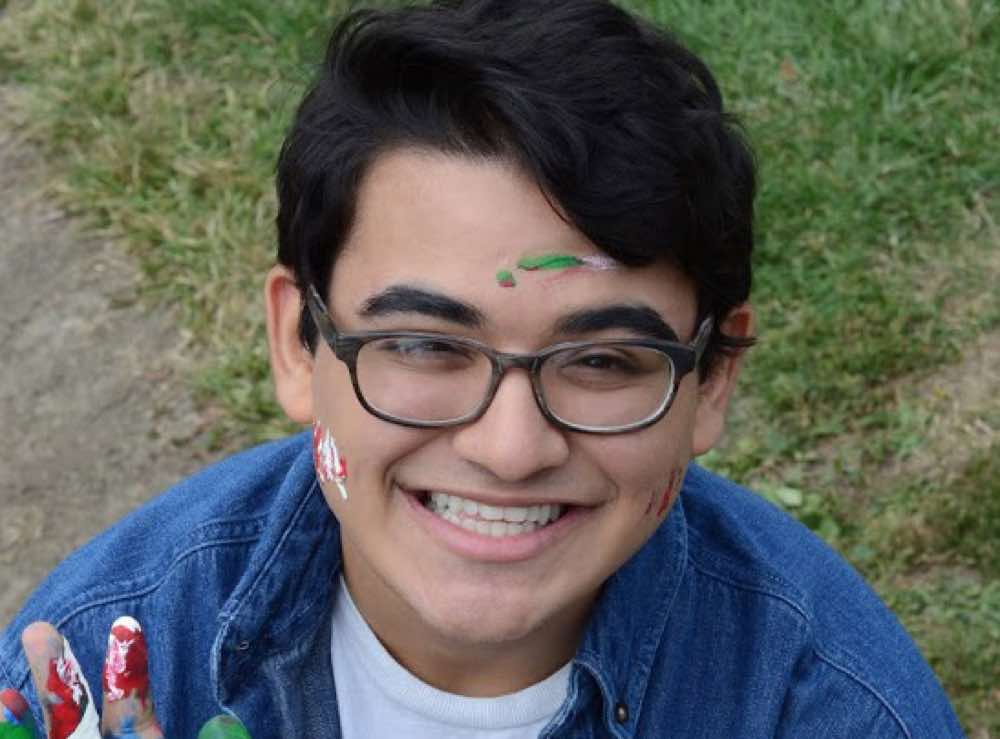

When older generation Pittsburghers talk about the Hill District, they reminisce about all of the amazing people, music, and the overall jovial atmosphere. This is exactly the way Sala talked about his neighborhood. On a walking tour, Sala was stopped by various people to say hi, ask how he was doing, invite him to a block party. It was easy to see that the feeling of community has not died with the gentrification of the hill.
This is what I wanted to capture in my piece. The colors are bright and cheerful, with a whimsical and expressionistic depiction of the architecture and the people. I wanted to capture that same feeling that the older generations have towards the Old Hill.
Chapter 3 Mikal Burns-Terney




My first piece is the moment when Mr. Udin is stuck in a foreign city with nowhere to turn. In the end, he contacts his aunt on a payphone. This part of the story was very significant to me because it shows how out cast someone could feel when he or she is in a different and unrecognizable place. It also shows the defeat someone could feel when he or she has to ask someone to take them in.
My second piece depicts the moment Mr.Udin realized this transition from everyday Pittsburgh kid to a well-mannered high school student. I feel like this was a significant moment not only for Mr. Udin, but also for African-Americans in general.
My third piece is an illustration of the moment Mr.Udin realizes he wants to make a difference as an activist. Who better to idolize in that category than Martin Luther King Jr.? I feel Mr.Udin is like the M.L.K of Pittsburgh, and it shows the starting point for that concept.
In creating the pieces, I chose to use ink and Copic markers. Those materials allow me the best control. I used a lot of color representation as well. For example, I used a lot of black and gold in the first piece to represent how he’s viewed as someone from Pittsburgh.
I feel very privileged to have had this opportunity to illustrate part of such an inspirational story. I’m very thankful for having been able to sharpen my skills as an artist with a story like this.
Chapter 4 Deaven Spruiel
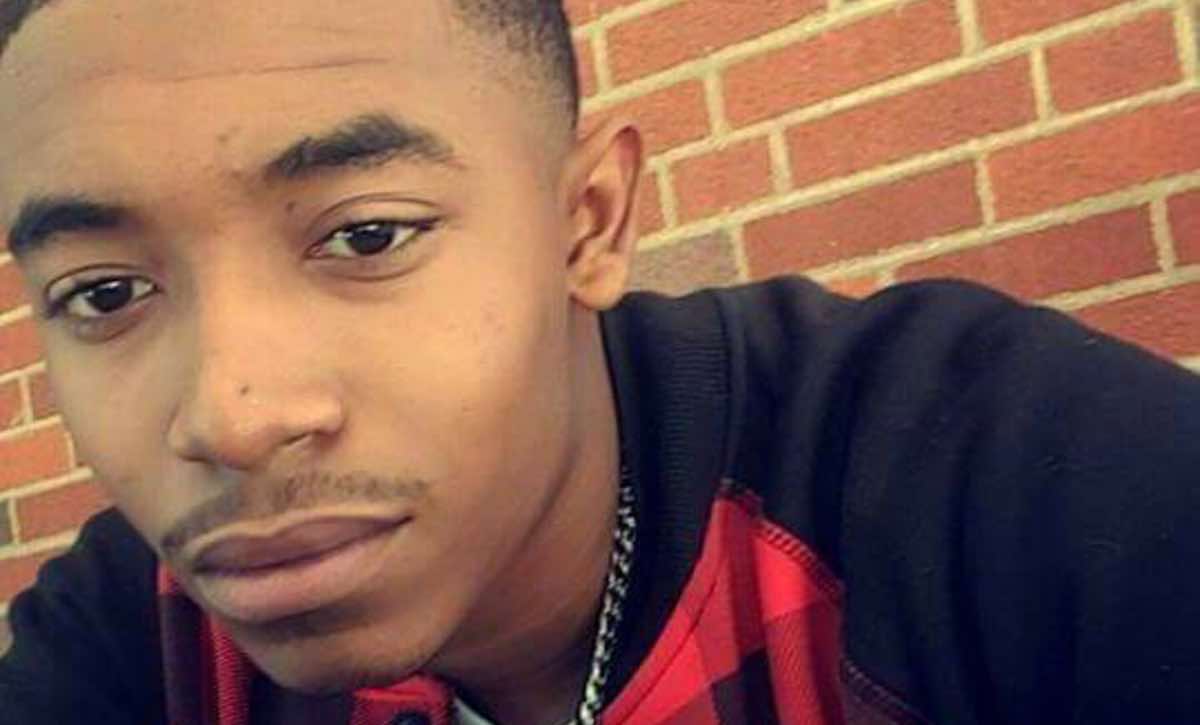

After talking to Mr. Udin and listening to some of his life experiences, one incident pulled me in more than the rest. That experience was the first time Mr. Udin went to Mississippi. Not only was that the first time Mr. Udin went to Mississippi, in 1965. it was also his first time that he encountered the South’s brand of prejudice. While Mr. Udin was telling me this story, I was creating images in my head of what he experienced. I was pulled into the experience party because I’m an African-American male growing up in a time in which prejudice is not as prevalent as it was in 1965 and before. Listening to how he was treated when he arrived in Durant and what he went through, I thought it was outrageous how people reacted, what they said and also how far they would go because of the color of his skin.
Chapter 4 Nell Hendricks
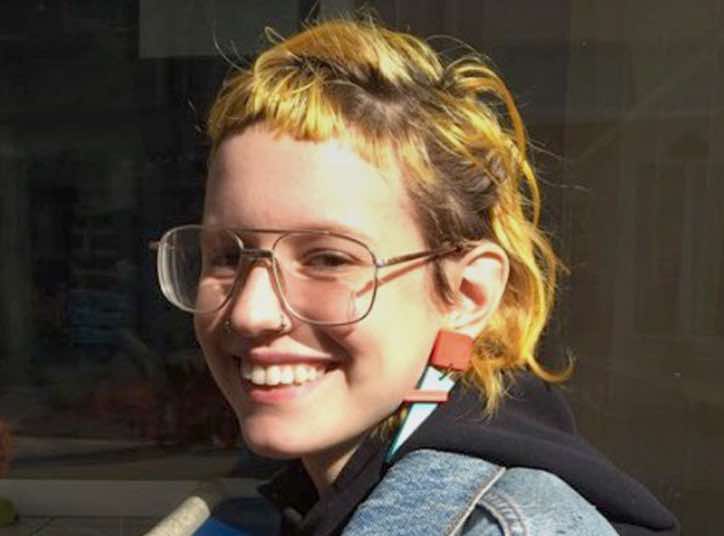

For this project, I chose to depict a scene from when he had just moved to a more independent life. I thought that this moment was important because it signifies the point in time when he moved to the stage of his life as a political activist.
Chapter 4 Victoria Kipiller

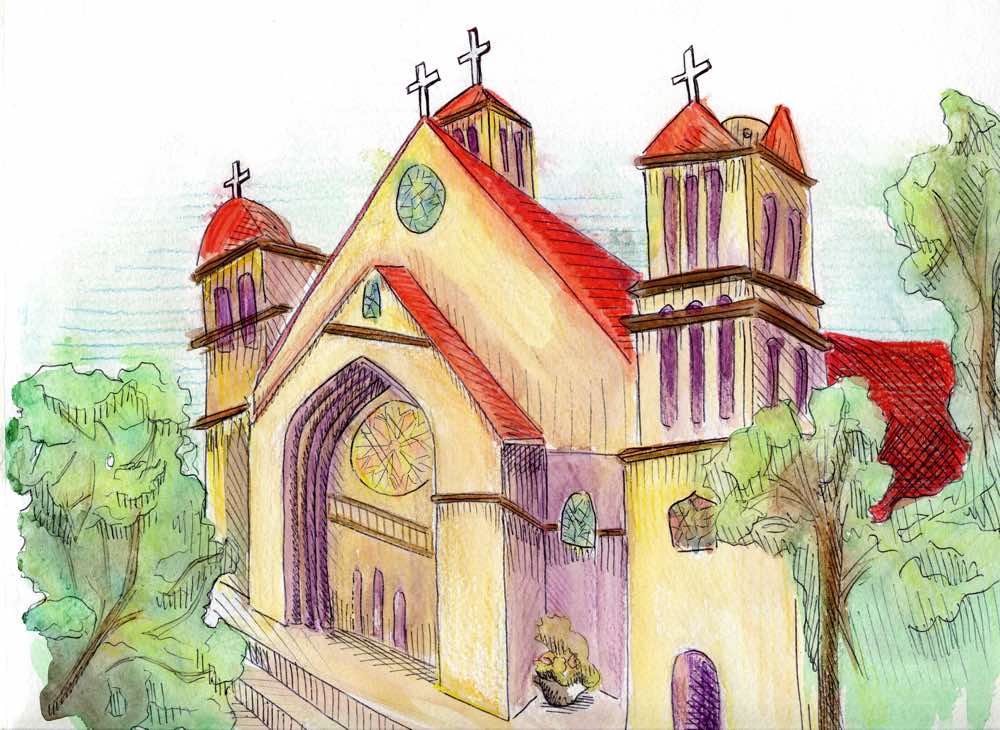
I am happy to have been given the chance to create illustrate this part in Sala Udin's life. He has been such an inspiration to me and my friends. This was such a great opportunity and with more publicity and larger audiences more people will be able to learn from others.
Chapter 5 Ada Griffin

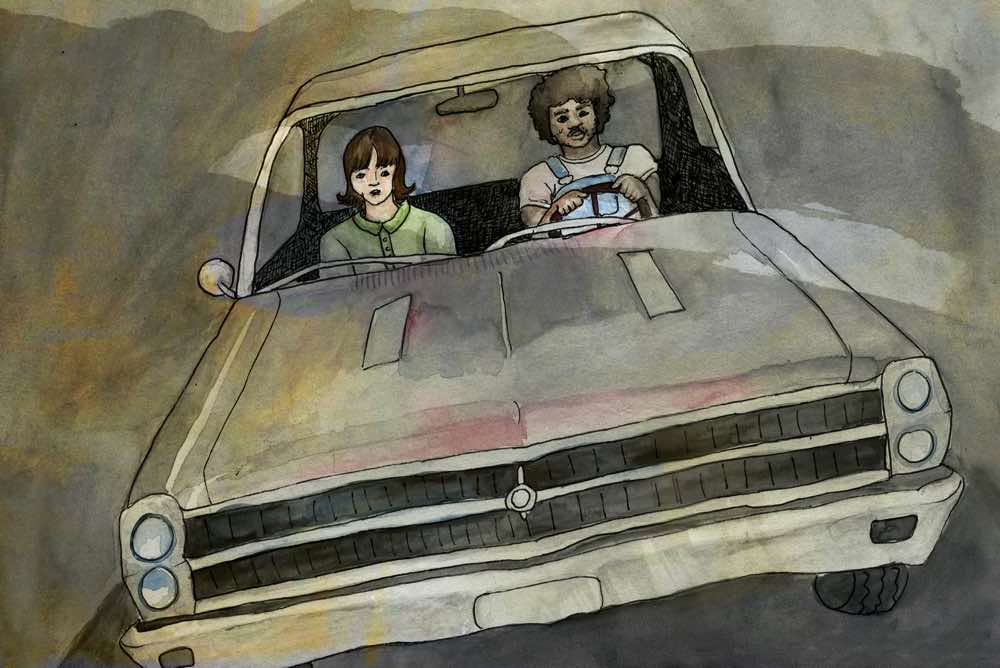
My illustration was inspired by the story of Sam Howze and his arrest in Mississippi. He was a civil rights worker who, in this story, was arrested and beaten because he was driving with a white woman in the passenger seat. I chose to depict the moment that Sam and his co-worker were pulled over because of the strong emotions of fear and pride that were tied to that moment. I chose not to depict the violence against Sam because I think that as a society we are exposed and desensitized to enough violence against Black bodies. I used watercolor and ink to render the final image.
Chapter 6 Olivia Grubbs


I felt that illustrating Sala with the city behind him was representative of his presence in Pittsburgh. He is able to address the people with such power and wisdom in his voice that everyone in the city could hear. I used bold outlines to represent and showcase the strength and significance that Sala has in the city's culture.
Chapter 7 LaShawn Parks


My piece relates to the police brutality that has happened in Pittsburgh throughout the years. The black hands represents "hands up, don't shoot.” Wylie Avenue is a very important street in the Hill district, where Sala grew up. Penn Avenue relates to a Pittsburgh street in Pittsburgh that cuts from the eastern boundary to Downtown. My goal was to truly relate this print to Pittsburgh, Sala Udin's life and police brutality. I took a linoleum block and carved out the negative space between the words. It resembles a stamp. I used black oil paint, rolled the paint on the lino block, and printed the image on paper.
Chapter 8 Cole Gradeck

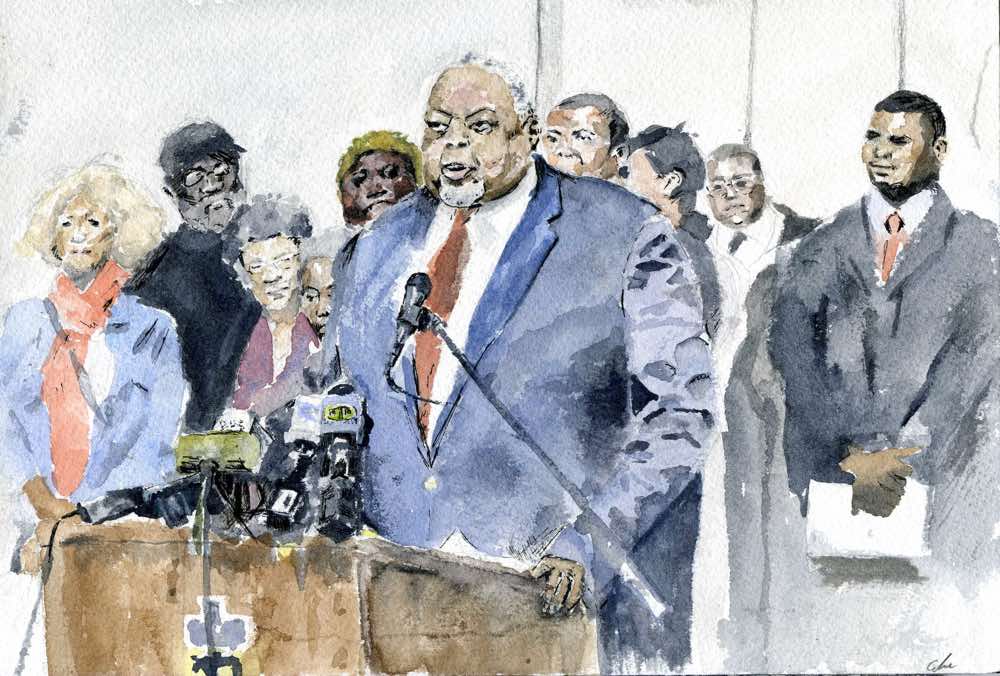
My piece focuses on Sala Udin’s time in the Pittsburgh City Council, fighting for the Hill District. Often council members aren’t well known so it was good to learn, through this project, more about Mr. Udin's work on council. I painted this image to show his constituents often stood with him during his time on council. I hope others look at his life through an artist’s eye as a result of this project. I was glad that I and so many other talented artists from CAPA were involved in this story. I used watercolor and ink for the finished piece.
Chapter 9 Sagar Kamath


This piece focuses on Sala and his emotions rather than his son. Sala is really thinking about his role as a father, how could he have prevented his son’s death? Was he somehow to blame? The piece shows Sala on a bench in a mournful setting, thinking about his son.
Chapter 10 Eryn Oberst

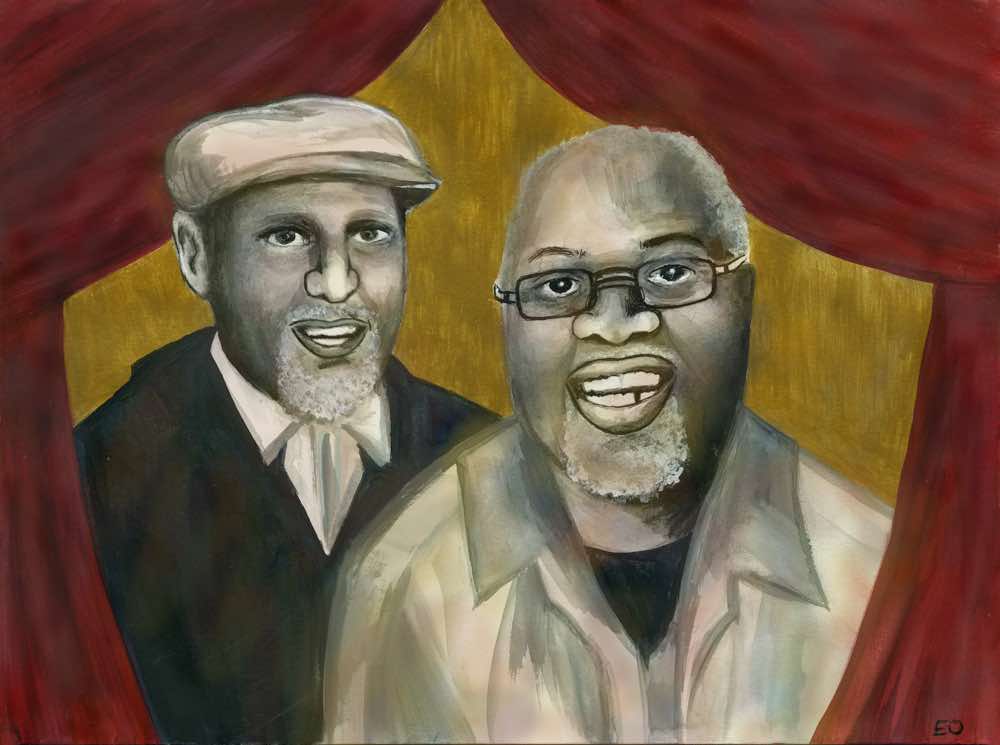
I chose to do a portrait of August Wilson and Sala Udin together to express their lifelong friendship and devotion to the arts in the African-American community. I decided to incorporate the background of an auditorium to include the hard work that Mr. Udin put into saving the August Wilson center. He insisted that there needed to be a space to showcase the history and culture of African-Americans. Mr. Udin was able to reconstruct a creative outlet while continuing the legacy of August Wilson. In my piece, I’m trying best to replicate the emotions and artistry exchanged during this time period.